I might be the perfect person to guide you through Prague, granting three days of awe. Why so? Because I’m an unusual kind of local.
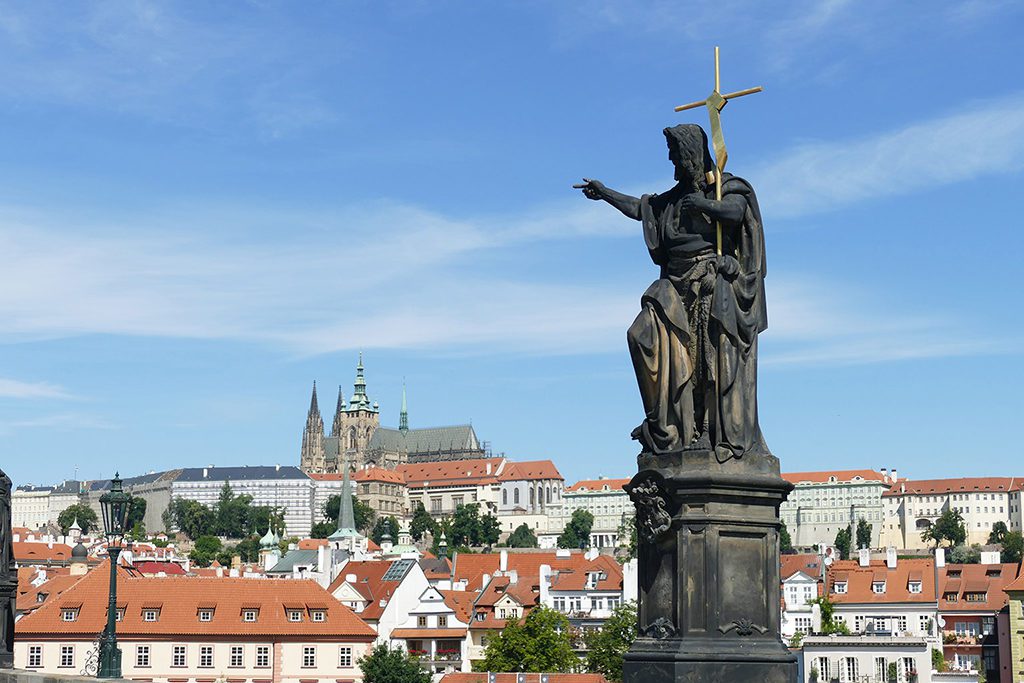
Locals know the best spots. They can communicate with other locals in the native language and, thusly, they might learn things visitors don’t.
On the other hand, locals tend to be oblivious to the beauty of their surroundings. Ignore iconic places. Bored by beauty.
So not being a real local actually works in my favor. I’m still amazed. And for some reason that I’ll explain below even deeply touched.
See? I’ve told you I might be your perfect guide!
If you have followed my blog for a while, you should know by now that I’m based in Hamburg, Germany. That’s from where the river Elbe flows into the Northern Sea which makes the city a self-proclaimed Gate to the World.
However, the source of this river lies in Krkonoše or the Giant Mountains. Those are in the Czech Republic, and that’s where I was born, hence, originally from.
A Story Of Occupations
Bohemia, the republic’s name before it even was a republic, was part of the Austro-Hungarian Empire. That’s one of the reasons for the strong influence and widespread of the German language. It’s also the reason for the many Czech-sounding names among Austrians.
Anyway, in 1918, in the aftermath of WWI, it became an independent state, and Prague, obviously, its capital.
Sadly, this happiness didn’t last for long since, in 1938, the German Wehrmacht occupied one part of the country. Then, in 1939, they took what was left.
No one intervened.
The British and French governments tried to avert war by deliberately satisfying Hitler’s territorial claims.
We all know how well that went.
After the liberation by the Soviet Army in 1945, the ČSR – short for the Czechoslovakian Republic – became the ČSSR and with that a satellite state of the Soviet Union.
Mind you, the added letter S stands for socialist.
Finally, now comes the part that was decisive for me. In 1968, Alexander Dubček tried to create socialism with a human face. It went down in history as the “Prague Spring”. Slowly, there was more freedom of speech, freedom of the press, and all those other freedoms that make most people quite happy.
Sadly, the Soviet government didn’t share this happiness and occupied the country by force of arms on August 21, 1968.
My parents left Czechoslovakia two months later, not knowing whether they would be able to return or see their families and friends ever again.
My Story
Settling On The Other End Of The River Elbe
So this is how I got to Hamburg.
We settled. My parents got jobs, I went to school. I had friends, I had foes. We had the status of legal immigrants. Only when I turned 18, I obtained German citizenship. By no means because I felt so German. It was simply easier to travel with a German document instead of this suspiciously blue Nansen passport.

Feeling German. That wasn’t easy.
Although my parents fled Czechoslovakia to Germany, they had still hard feelings towards their host country because of the past. After all, during their childhood, German troops had occupied their home country. Czechs had to endure terrible Nazi Barbary.
Hence, making peace was difficult. Consequently, assimilating was not a valid goal.
Especially since at that time – only a little over 20 years after the end of WWII – Germans were not that popular among other nations.
German was a human stain.
I cannot even count how often I hurriedly affirmed having a German passport, but actually being Czech. By no means German.
Tables Turn
End of 1989, David Hasselhoff was looking for freedom which allegedly made the walls come tumbling down. First, the Berlin wall, followed by the Velvet Revolution in the Czech Republic. It was a non-violent transition of power from a communist one-party state to a democratic republic.

In September 1990, on the occasion of my mother’s 50th birthday, we visited Prague for the first time after 22 years.
It was very strange. Suddenly, this quirky intra-familial language of ours was everywhere. There were even signs in Czech.
Weird, man, very weird.
Those were my people? This was my home?
What did we have in common? Did we have anything in common?
My upbringing had been so different from theirs.
My experiences, my values, my viewpoints.
22 years is a long time and leaves traces and marks, especially on a very young person.
Did I feel happy? Did I feel like I had come home?
No.
My mom did.
She was the long-lost daughter coming home to the fatherland.
I was a visitor from the wealthy, capitalist west. The one that spoke Czech, albeit, with this weird German accent.
I felt deceived, defeated, disarmed.
And most of all deracinated.
It was then that I lost my home, not in 1968.
It was a hurtful insight.
Slowly, it didn’t feel false to claim to be German. Without quickly adding that I was actually from Czechoslovakia.
Czechoslovakia was a beautiful country. But it was not my home.
Exploring The City
To me, Prague, together with Venice, is the most beautiful city in all of Europe. There are tons of mesmerizing landmarks and buildings. But, as a matter of fact, there is beauty everywhere, not only in designated spots.
That makes it impossible to see everything in three days, obviously.
Therefore, guiding you through the city, I’ve grouped it into various categories and fields of interest. I think this is a good way to provide you with comprehensive information without confusing and overwhelming you.

I’m introducing the three best exemplars in each category. This way, you can compose your itinerary focusing only on the sights that interest you the most.
As a first-time visitor, you might want to pick the first, literally top suggestion of each group to make your visit most complete.

Notwithstanding, if one of the categories doesn’t interest you at all, you just skip that section.
No worries, there will be enough left, you certainly won’t get bored.
If you’ve been to Prague before, you have probably already seen those most iconic places. Hence, maybe the two other ones might be an unexpected inspiration?! Or perhaps you find a whole different side of Prague on my list.
No matter how you put together your personal itinerary, on the map at the end of the post you’ll see where all these places are located. This will make your planning easy and efficient.
But now let’s go, we have a full schedule!
The Three Best…
Squares
1. Old Town Square
The Staroměstské náměstí is the oldest and most important square in Prague and an inevitable tourist magnet. No wonder since many historical buildings of different architectural styles are surrounding this immense square.
German and Jewish merchants and local craftsmen commissioned the first structures in the 10th and 11th centuries. The main reason for choosing this spot was the convenient location at the intersection of important trade routes and the existence of a ford – near today’s Charles Bridge – on which the river could be crossed.
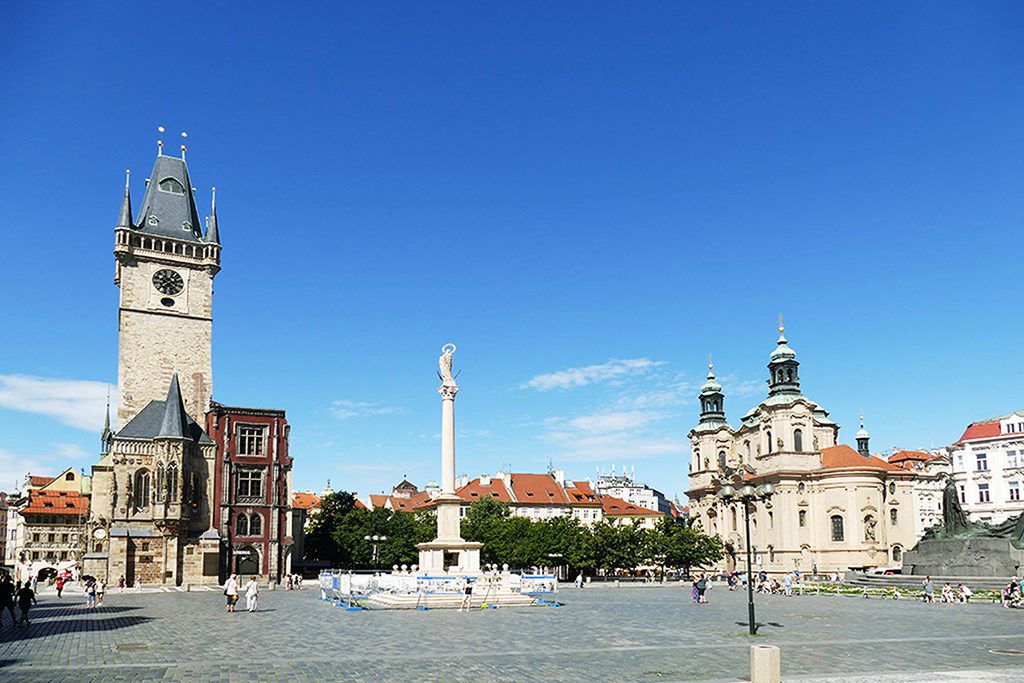
There is the Old Town Hall with the world-famous astronomical clock. Whereby, quite honestly, I don’t get the fuss since, for instance, at the Glockenspiel in Munich there is much more going on.
Sacral Structures
There is the iconic Gothic Tyn Church, the Baroque St. Nicholas Church, the Rococo Palace Golz-Kinsky, and many other stately town villas.
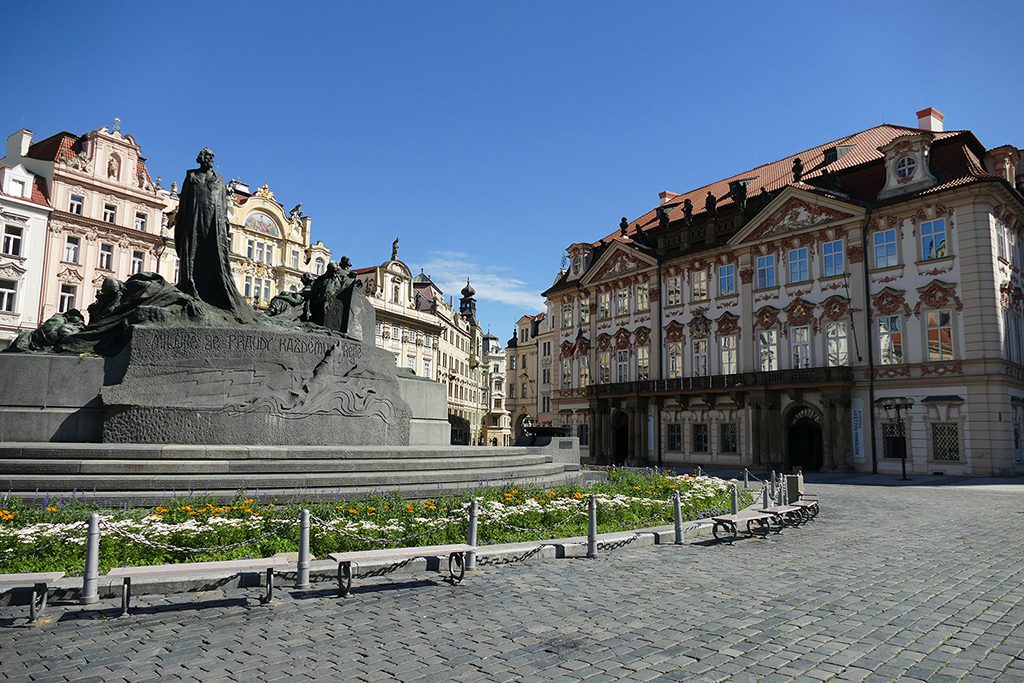
The Romanesque and early Gothic houses stood two to three meters below the level of today’s streets. Since there was a constant threat of flooding from the nearby Vltava, artificial embankments started already at the end of the 13th century. Gradually, they raised the street level.
The ground floors are cellars now.
A very clear and impressive example is the New Old Synagogue where you have to walk down quite a few steps to get to the former street level.
2. Wenceslas Square
Wenceslas Square is not only one of the largest squares in Europe. It is also a place where many historic and political events took place which were of major significance to the Czech people.
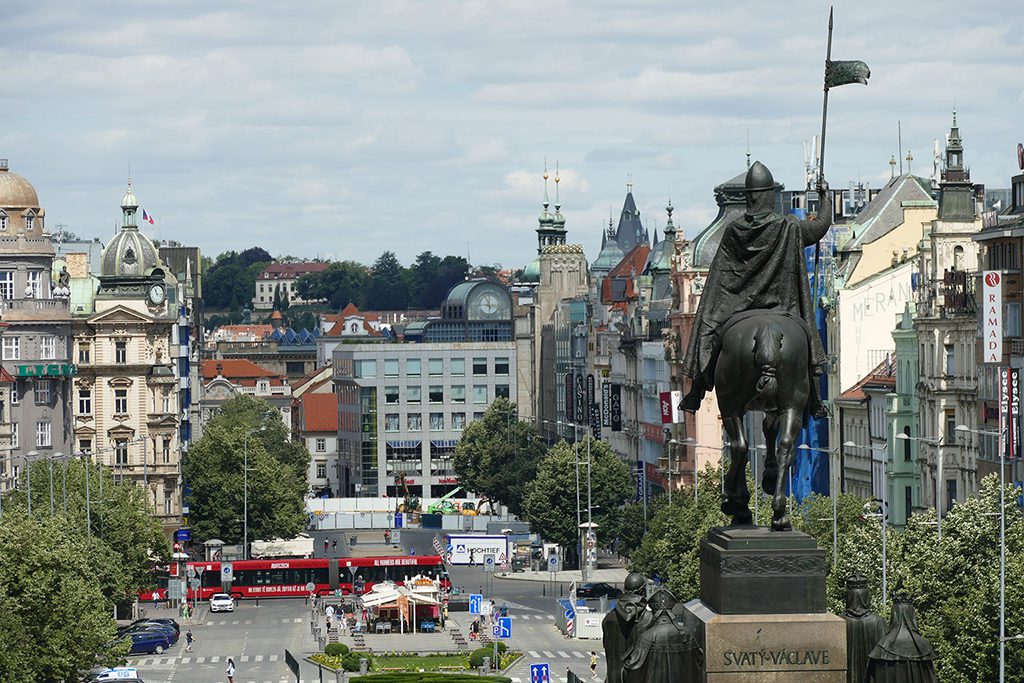
In 1348, with the founding of Prague’s New Town under King Charles IV., they installed also a new market – a horse market, to be precise.
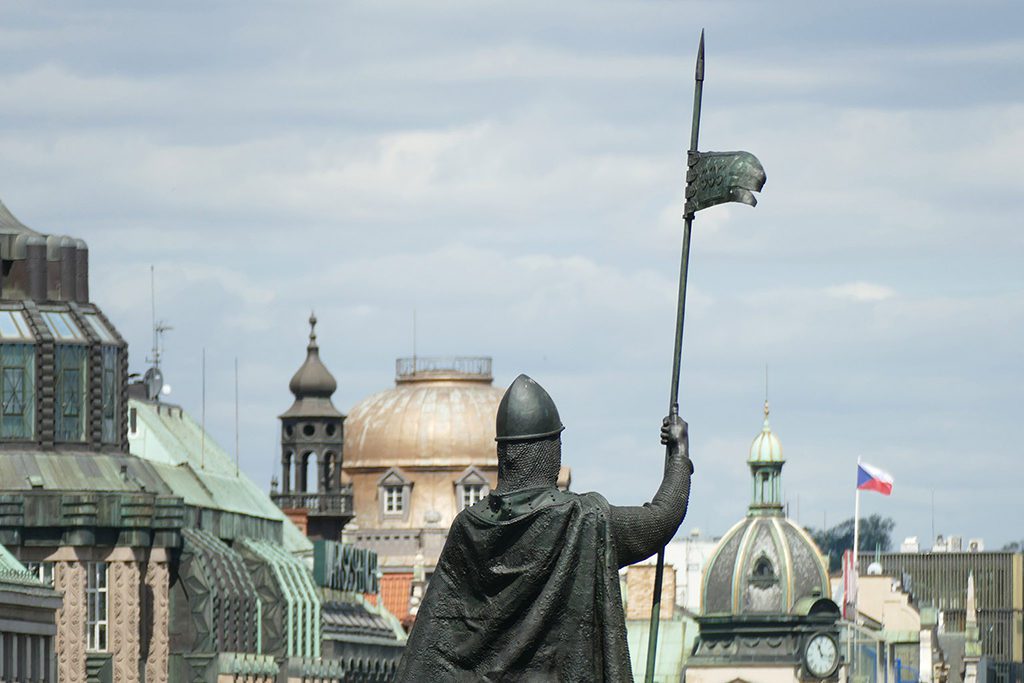
The name of Saint Wenceslas of Bohemia got the square – which is actually rather a broad boulevard – only in 1848.
The Martyrs of Wenceslas Square
On January 16, 1969, hence, five months after the invasion of the Warsaw Pact of Czechoslovakia, 20-year-old student Jan Palach burned himself and ran up in flames from the National Museum to Wenceslas Square. This was in protest against the occupation.

Today, a monument on the site below the Wenceslas statue commemorates Palach as well as Jan Zajíc who repeated this public protest in the same place only one month later.
But Wenceslas Square also stands for positive development. Alexander Dubček, who had been the initiator of the Prague Spring and at that time the republic’s president, spoke together with Václav Havel, a writer, former dissident, and after the Velvet Revolution president from 1989 till 2003, during a mass rally on Wenceslas Square in November 1989. From the balcony of house number 56, they called for the country’s political transformation. A couple of weeks later, communism in Czechoslovakia was abolished.
After Havel’s death in December 2011, thousands of people mourned in Wenceslas Square.
By the way, due to the invasion and oppression, to this date, Czechs tend to be rather reserved towards Russia. For instance, the older generation had to learn Russian in school, nevertheless, they aren’t exactly keen to speak it. So don’t expect a big smile and a hug if you address Czech people in Russian.
3. Hradčany Square
Actually, my favorite of Prague’s many majestic squares is Hradčany Square way up high in the castle district.
Magnificent Renaissance and Baroque palaces surround this lovely square. In the East, it borders directly on the castle’s main portal.
Nonetheless, don’t focus only on the castle but take a closer look at the other exalted structures like for instance the very uniquely decorated Schwarzenberg Palace. This venue is part of the National Gallery and houses the Old Masters – see also the chapter on museums below.
On the Southern side is a viewing platform where visitors have a wonderful view of the entire city.
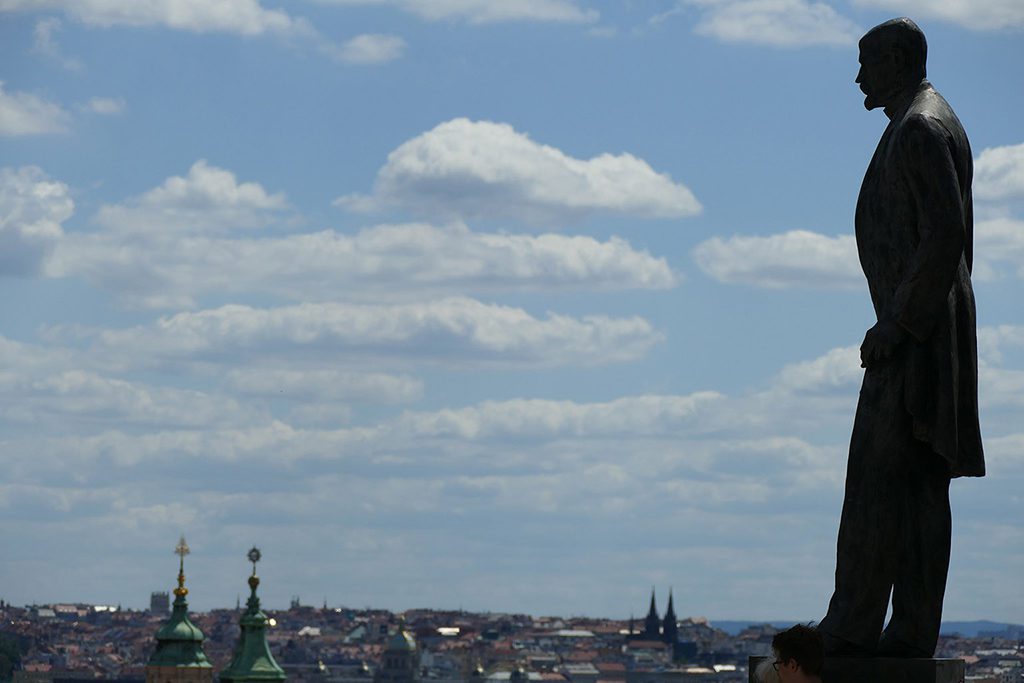
Here, he is overlooking the city of Prague from his corner on the Hradčany Square.
A massive, richly decorated grille separates the courtyard of honor from the Hradčany Square.

State guests drive across the Hradčany Square to the President’s seat. It is also the main entrance for visitors to the castle area.
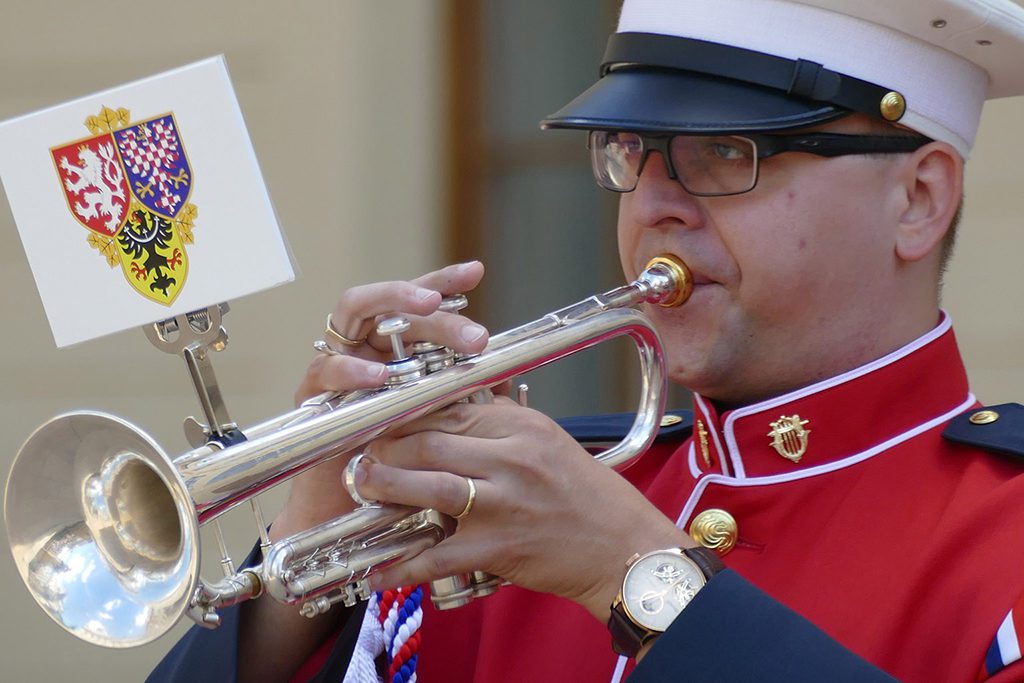
A ceremonial changing of the castle guard takes place every hour in front of the entrance portal of the court of honor.
In 2009, President Barack Obama held a speech on the Hradčany Square during his visit to Prague.
Bridges
1. Charles Bridge
This is certainly not Prague’s best-kept secret and definitely not off the beaten paths. However, Karlův most, the Charles Bridge is so beautiful, for this bridge alone a trip to Prague is worth it.
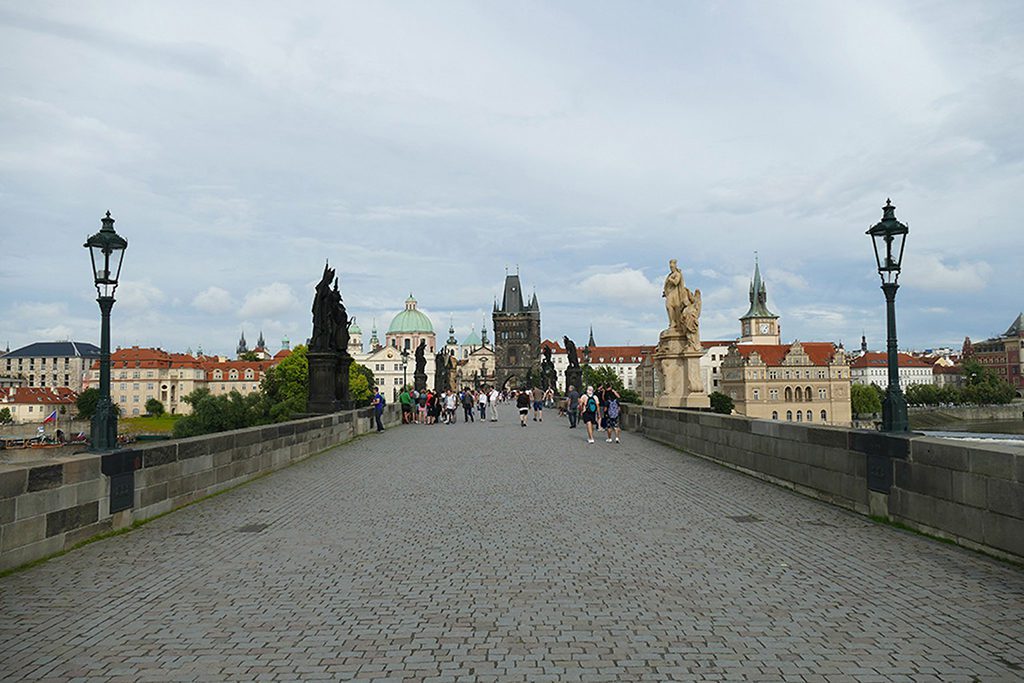
You have all those magnificent views of the surrounding parts of the city, you dream yourself away on the waters of the Vltava, or you admire the 30 incredibly artistic statues that are guiding visitors across the bridge.

The foundation stone of the Charles Bridge was laid in 1357 by Emperor Charles IV and today, Charles Bridge is actually the oldest surviving bridge over the Vltava river and one of the oldest stone bridges in Europe.
Building Bridges – Literally
This bridge made Prague an important hub in trade between Western and Eastern Europe. Also, the coronation route of the Bohemian kings led over the bridge.

When Charles Bridge was inaugurated, it didn’t have any decoration. Beginning in 1629 and predominantly in the early 18th century, beautiful sculptures of saints and patrons were erected on the bridge pillars. They came from various sculptor workshops and are predominantly in the Baroque style.
Nevertheless, since 1965, the antique stone figures have been replaced by replicas step by step. The originals are kept in the Lapidarium of the National Museum.
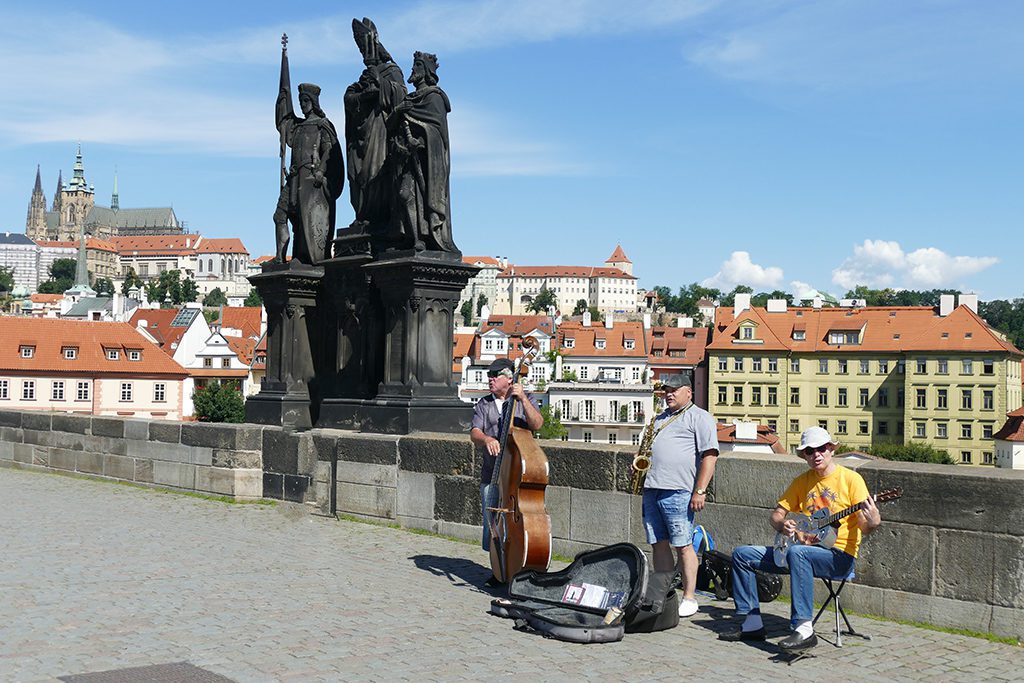
So a stroll across the Charles Bridge is indispensable when visiting Prague. Besides the beauty of the bridge itself and the breathtaking surroundings, there is also a lot going on. There are vendors selling all sorts of souvenirs. Artists offer paintings. Or you can get your portrait taken by a caricaturist right on the spot.
However, while you are awing at the sceneries and having fun with the peddlers, mind your personal belongings. Places like these are the main spots for pickpockets.
2. Mánes Bridge
The Mánes Bridge is the tenth bridge downstream and the Charles Bridge’s Northern neighbor. It crosses the Vltava between the Jewish quarter of Josefov and Klárov on the Western bank. Although it is a concrete bridge, it has something light and dainty to it.
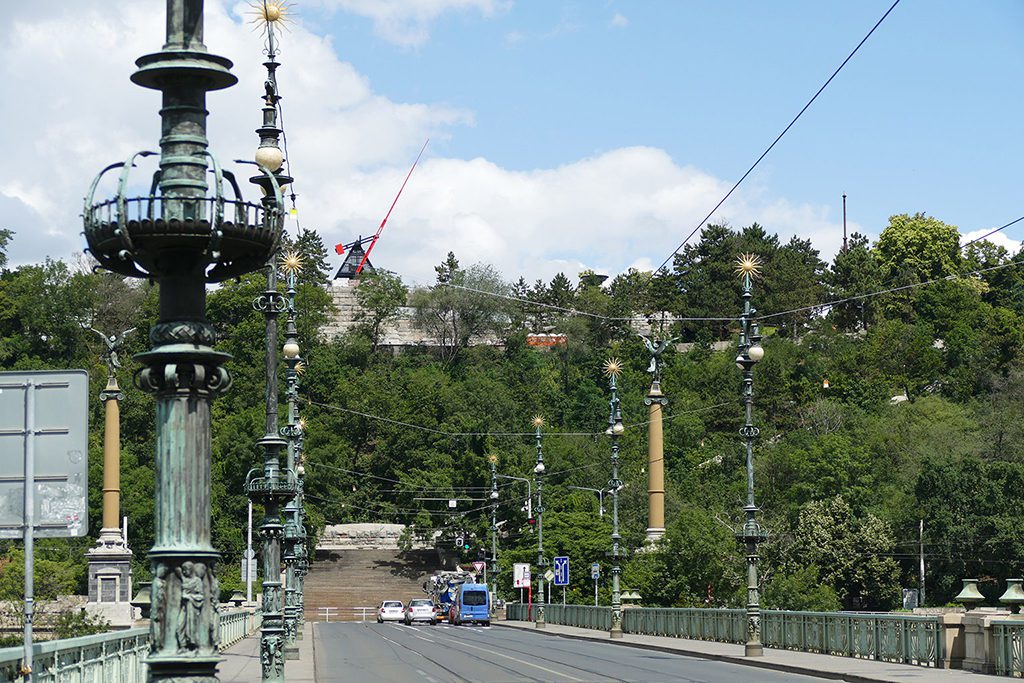
I guess it’s mainly because of the slim pillars. They are decorated with friezes of Vltava swimmers and topped by charming golden suns.
There is a statue of the painter and name-giver Josef Mánes on the bridgehead towards the historic city center.
3. Legion Bridge
The so-called Czech Bridge of Legions lies South of the Charles Bridge – and that’s actually its strongest suit.
From this bridge, you have a grand view of the entire Malá Strana, the Charles Bridge, and the iconic Hradčany, the castle district, in the backdrop.
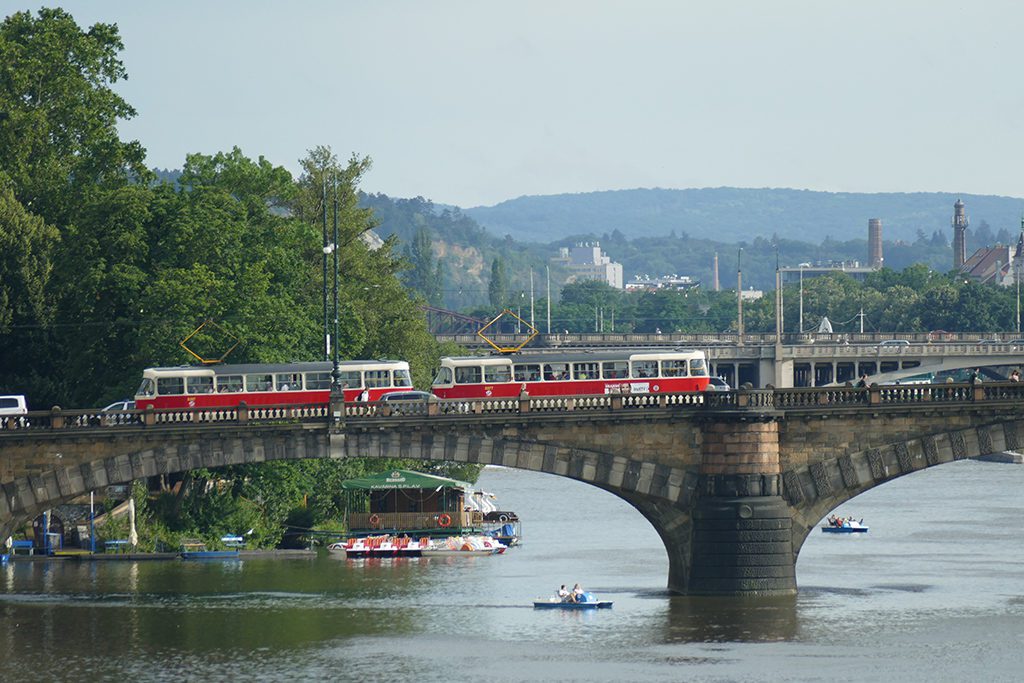
Hence, the Legion Bridge is definitely one of Prague’s best photo spots.
Towers
1. Powder Tower
Since they also call Prague the City of Spires, choosing only three is really a toughie.
Nevertheless, I picked the three most iconic ones, beginning with the Prašná brána, the Powder Tower. This 65-meter-high tower was built as part of the fortification in the 15th century.
This late Gothic tower marks the entrance to the historic old town.
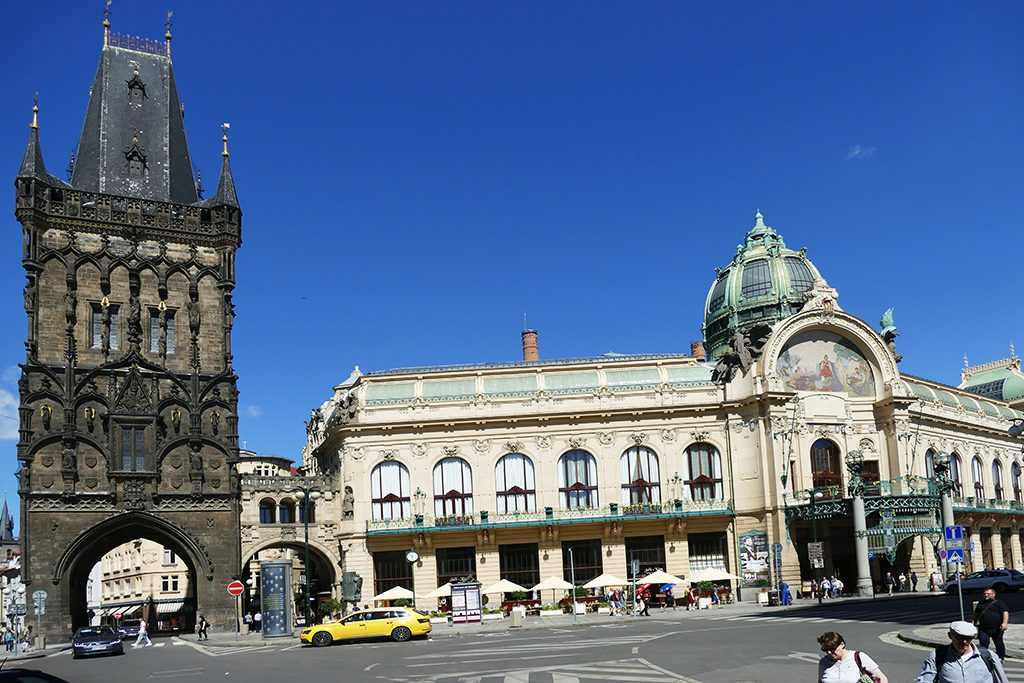
It is called Powder Tower because black powder was stored inside until the late 17th century. Also, the tower marks the starting point of the historic royal route to Prague Castle.
In the late 19th century, the Powder Tower was restored in a Gothic Revival style according to the Old Town Bridge Tower.
Which, obviously, brings us to the…
2. Old Town Bridge Tower
In 1380, the Old Town Bridge Tower was built above the first bridge pillar on the Vltava’s East bank towards the historic old town.
The tower is still a historic political monument. For ten years, the heads of 27 insurgents were exhibited on poles. They were beheaded for the uprising against the Habsburgs in 1618. Also, a plaque placed in 1650 commemorates the freedom fighters opposing the Swedes in 1648.
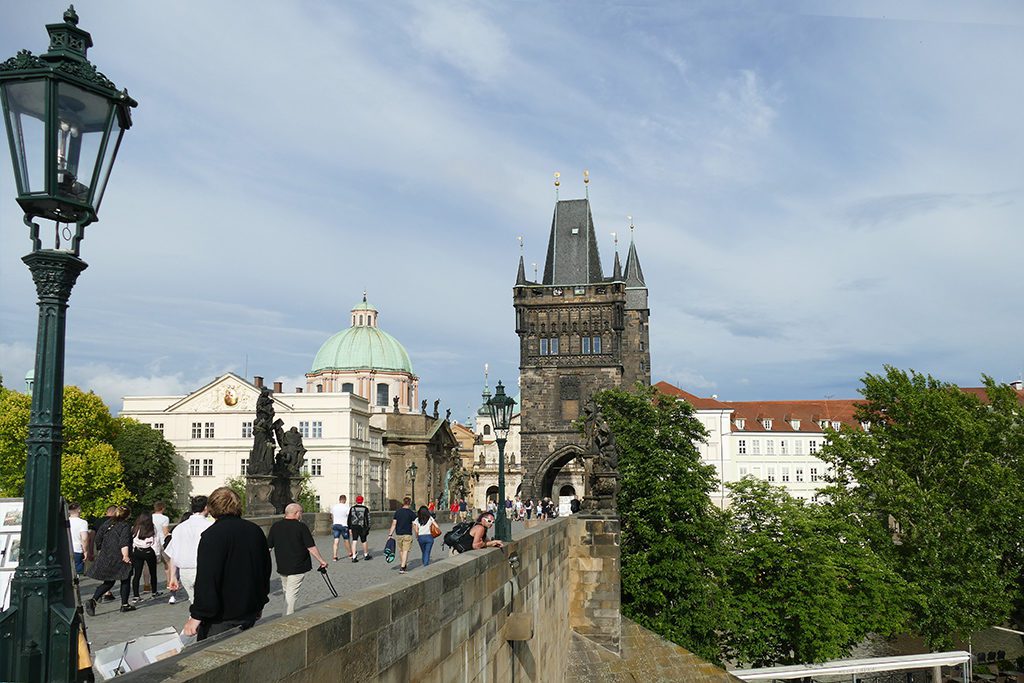
On the west side, the tower is decorated with the coats of arms of all countries that belonged to the Bohemian Kingdom at the time of building the bridge. Also, there is the coat of arms of the Roman emperor, the coat of arms of the Bohemian king, and – as a symbol of Wenceslas IV – a kingfisher framed by a veil.

At the height of the second floor of the tower, Saint Wenceslas is depicted as the patron saint of the bridge.
Visitors can climb up to an observation deck.
Occasionally, a historically dressed trumpeter blows the visitors’ minds.
3. Great South Tower of the Saint Vitus Cathedral
Saint Vitus Cathedral, located on the castle’s premises, is one of Prague’s most important landmarks. And the Great South Tower is especially special.
Initially, it was built in the late 14th century and then reconstructed in the 16th and 18th centuries. The tower holds the largest bell in the Czech Republic, called Zikmund, which dates from the 16th century.
Visitors can climb up to an observation platform. This way, they get to see the bell on their way up where they finally enjoy spectacular views.
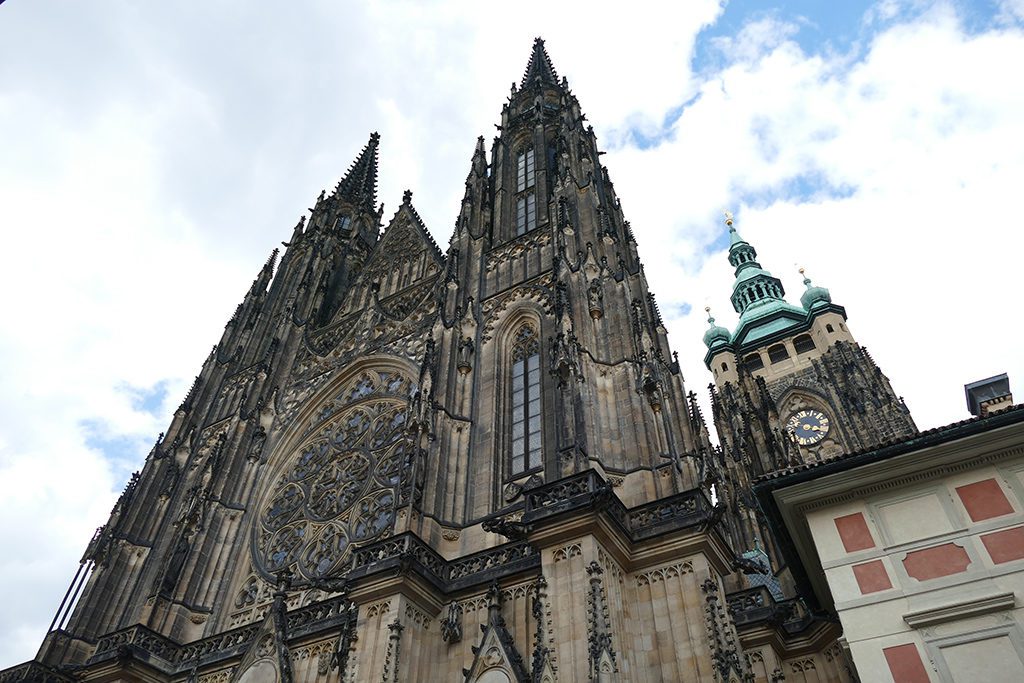
The tower is 90 meters high and you reach the platform over 287 narrow, winding steps.
Climbing up the Great South Tower is not included in the general castle ticket. You can buy it separately for 150 CZK.
This, of course, brings us to the first of the unmissable…
Churches
1. Saint Vitus Cathedral
Saint Vitus Cathedral on the castle’s premises is the largest church building in the Czech Republic.
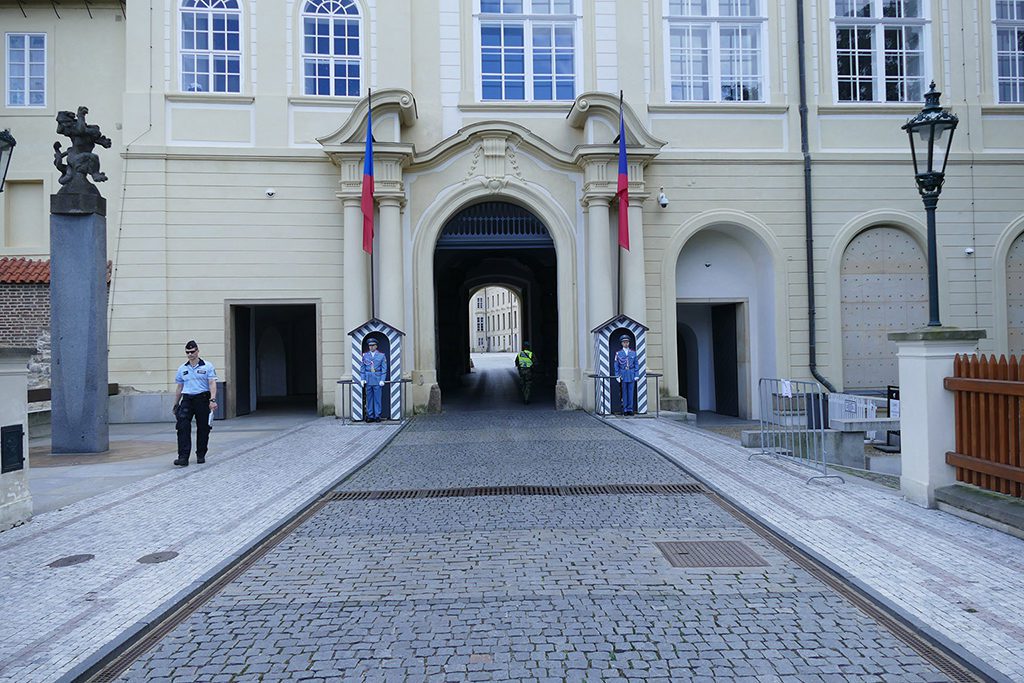
Commissioned by Crown Prince Charles, in 1344, it was designed by French architect Mathieu d’Arras. Eventually, it was continued by German architect Peter Parler. Saint Vitus is architecturally and stylistically groundbreaking for the development of late Gothic.

I find that it actually does resemble Notre Dame a bit, don’t you think?

Upon coronation, the Bohemian kings moved in a solemn procession along the royal route from the old town into the cathedral.
To this date, the cathedral houses the coronation insignia in the crown chamber.
Also, many of the Bohemian Royals and Holy Roman Emperors have their tombs at Saint Vitus.
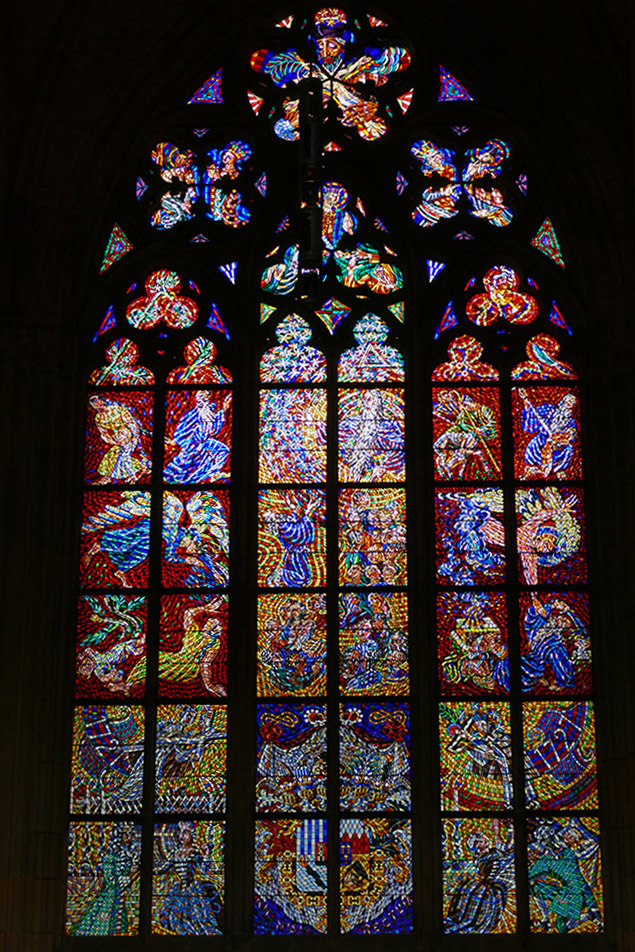
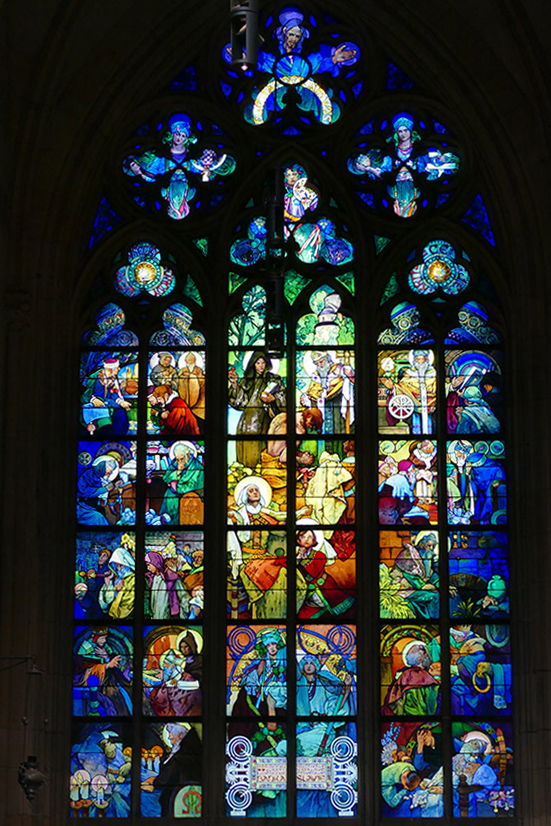
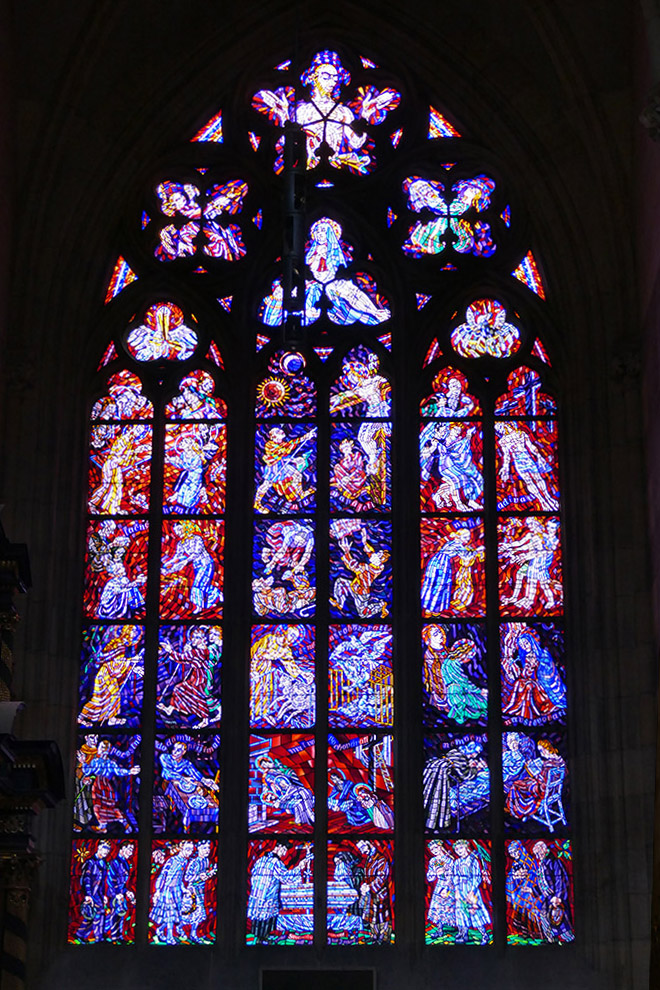

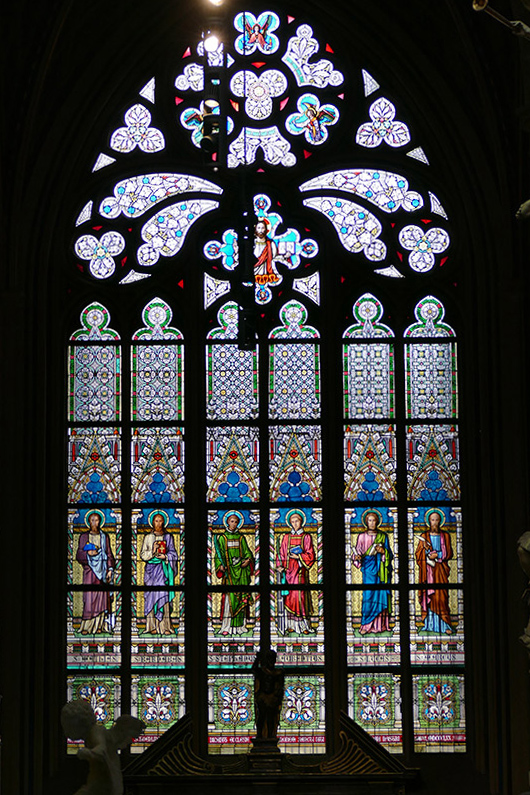
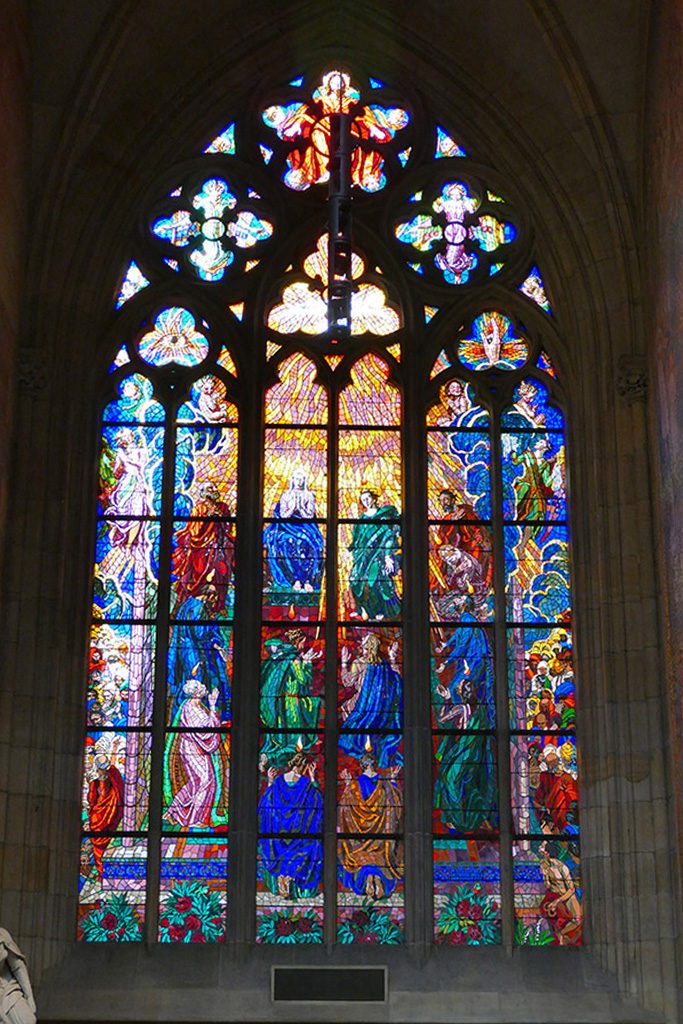
As a matter of fact, I love the beautifully designed windows the most. Some of the most exquisite church windows I’ve ever seen.
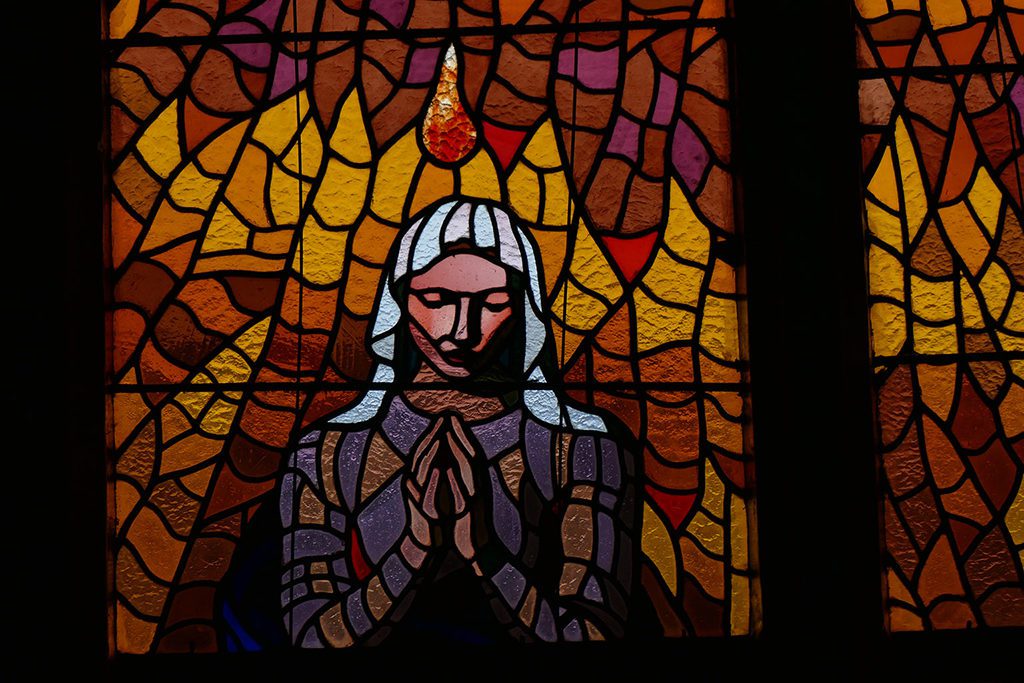
The Cathedral has been, obviously, part of the World Heritage Historic Center of Prague since 1992.
2. Saint Nicholas Church
At the Lesser Town Ring on the Western bank of the Vltava river stands the Saint Nicholas Church and the adjacent former Jesuit college on a precious little square.
The foundation stone for this church – actually, one of the most important baroque church buildings in Europe was laid in 1673. However, the Jesuits started the actual construction only 30 years later.

After the dissolution of the Jesuit order in 1775, Saint Nicholas became the Catholic parish church of the Lesser Town.
Besides the regular services, they are often concerts taking place at the church because of the excellent acoustics.
Until the late 19th century, the bell tower was used as a watchtower against enemies from the outside. From 1950, agents of the communist secret service used the tower to observe the many embassies of Western countries that are located in the neighborhood. Practically the enemies inside.
3. Church of Our Lady of Victory
Not far from Saint Nicholas is another important house of worship, namely the Church of Our Lady of Victory. This one belongs to the Carmelite Congregation in the Czech Republic.
The church was built in 1611 as the Holy Trinity Church of the German-speaking Lutherans. This is probably the reason why the building is not that lavishly decorated. Protestants are rather clean-cut in their appearance.
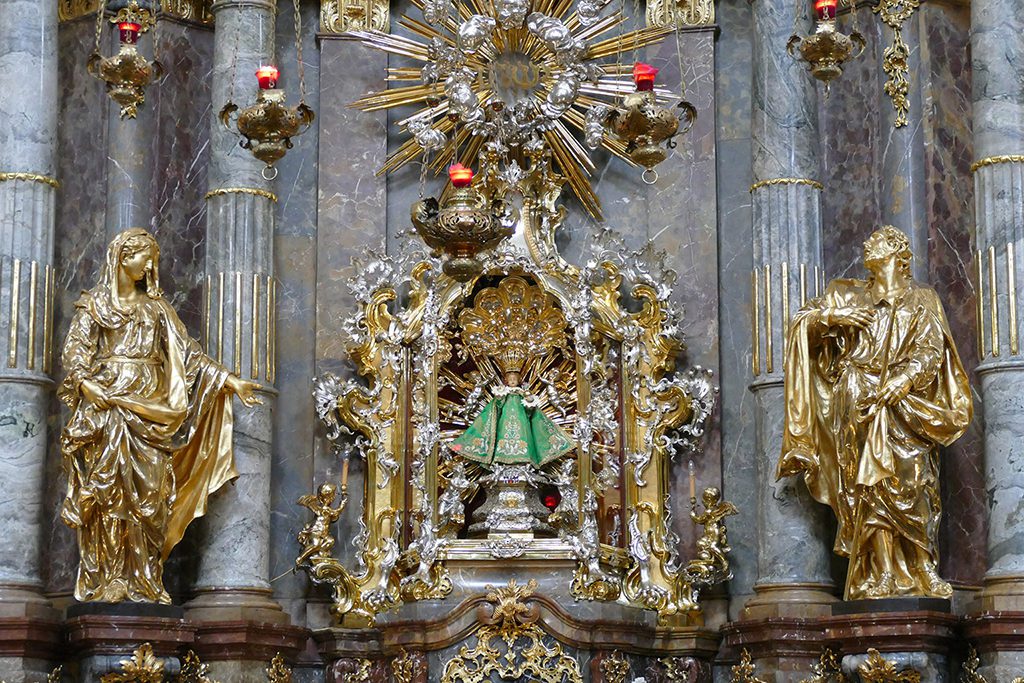
Recatholization began in Prague after the victory of the troops of the Catholic League in the Battle of the White Mountain in 1620. The church was handed over to the Carmelites in 1624 and consecrated by the papal nuncio to the Virgin Mary of Victory. End of the 18th century, however, the Carmelites had to give up the church.
After almost 210 years, the Church was handed over to Italian Carmelites of the Ligurian Province in 1993.
Monasteries and Abbeys
1. Strahov Monastery
Strahov is an abbey of the Premonstratensian Order and is located West of the Hradčany district.
It is mostly known for its huge library containing numerous unique pieces, prints, manuscripts, engravings, and maps in addition to a vast book collection. One of its greatest treasures is the Gospel Book of Strahov, a manuscript from the 9th and 10th centuries.
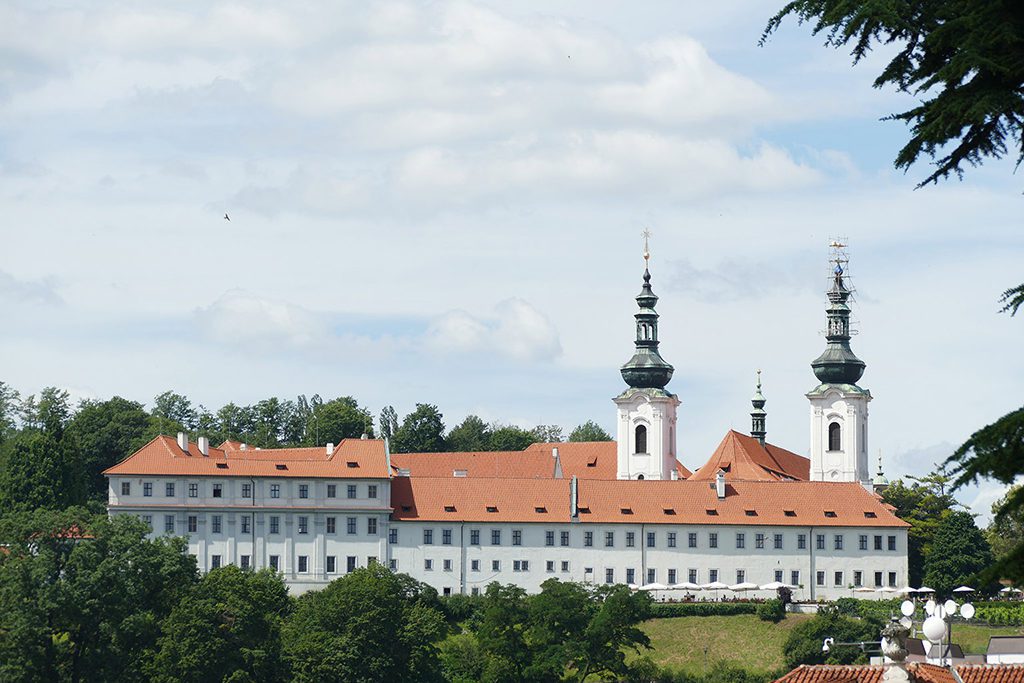
However, the entire complex is really beautiful and a great place for a short break. Actually, the Bellavista restaurant just outside the monastery’s walls has definitely earned its name: It’s one of the best viewpoints above the center of Prague – and this is in a city that’s literally surrounded by great viewpoints. Just check the Panoramic View section below.
What makes this panoramic platform extra beautiful are the vineyards just below. The leaves slightly obstructing the views of Prague will make your pictures particularly charming.
Oh, talking ’bout wine: There is, of course, also beer. The monastery’s brewery, which has existed intermittently since the 12th century, was reopened in 2000 under the name Klášterní Pivovar Strahov. Cheers to that!
2. Convent of Saint Agnes
Saint Agnes is a convent from the 13th century. It is named after its founder Princess Agnes of Bohemia and is located in the very city center. The convent was actually the first double monastery north of the Alps since it housed also a minority of Franciscan friars. As a matter of fact, the structures are actually one of the most important works of early Gothic architecture in Prague.

Today, Saint Agnes is one of the National Gallery’s venues and shows medieval sacral art. The oldest collection piece is a late Romanesque statue of Mary from Moravia.
In contrast, at the convent’s garden, contemporary sculptures are presented to the public.
Talking ’bout public: Entrance to the garden is free, only for the indoor exhibitions a ticket is required.
3. Loreto
After the Catholic League’s victory in the Battle of White Mountain in 1621, a comprehensive recatholization led to the establishment of Loreto pilgrimage sites across all of Bohemia. This was a measure to regain interest in the Catholic faith.
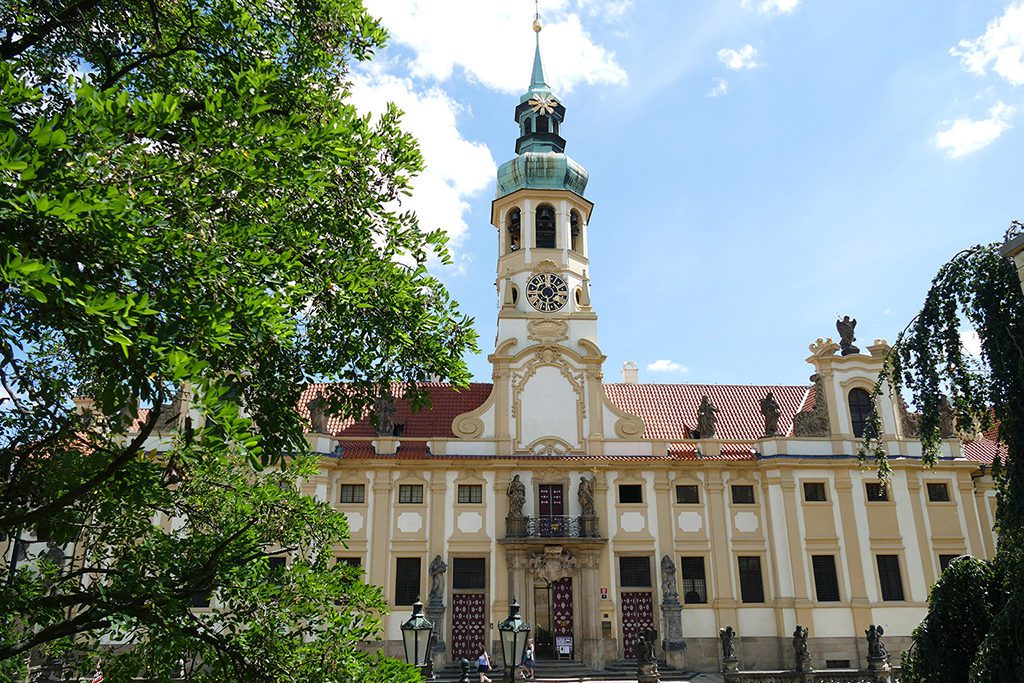
The rather small Loreto chapel stands in the courtyard of the building complex with a large nave, bell tower, and side wings. It is a replica of the Casa Santa in the Italian municipality of Loreto. The construction of the Prague Loreto, however, lasted from 1626 to 1750.
The most famous and precious treasure is the so-called Prague Sun. It is a monstrance made of gold-plated silver in Vienna in 1699. Adorned with 6222 diamonds, it is almost a meter high and weighs 12 kilograms.
Prague Castle
Contrary to many other castles around Europe, the Prague Castle is not just one majestic building with some stables. It’s actually the largest coherent castle complex in the world. On an area of around 70,000 square meters are many stately buildings of various architectural styles, houses of worship, and – yes – the structures of the original residence building. However, if you expect something like Versaille or Neuschwanstein, you’ll be disenchanted. This castle was built already at the turn of the 9th and 10th centuries. Therefore, it deems massive, however, rather austere.
Together with the entire historic center of Prague, it has been a UNESCO World Heritage site since 1992.
I’ve already introduced some of the most important parts such as the Saint Vitus Cathedral. However, here are my other personal highlights.
1. Golden Lane
My mother always remembered with a certain melancholy how she used to take me to the Castle’s Golden Lane. No wonder, you don’t need to invent anything fantastic there. This lane on the inner wall of the Castle looks like it was built for a fairy tale movie.

It’s said that alchemists worked here to produce artificial gold and the Philosopher’s Stone. Although it’s true that Emperor Rudolf II had contracted alchemists, those were working rather at the Mihulka tower.
The Tenants
Ironically, today’s tenants are probably much richer, anyway, by selling all kinds of Bohemian handicrafts and souvenirs to the many, many visitors from around the world.

These in total eleven tiny houses date from the 16th century and were initially built to accommodate Emperor Rudolf’s castle guards.
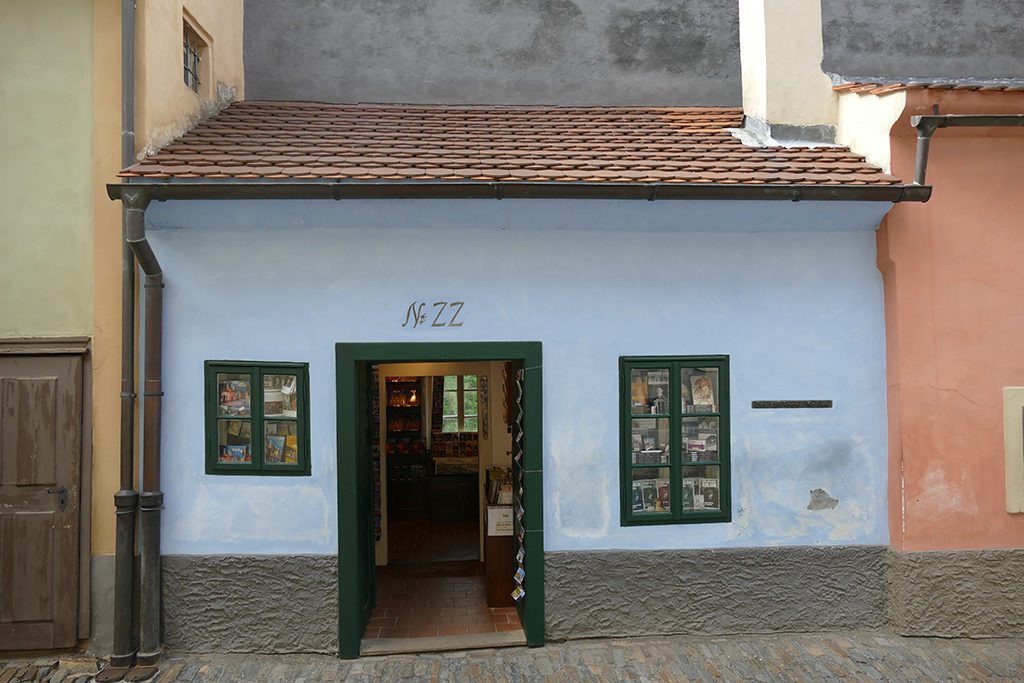
Only later, goldsmiths moved into the houses. Hence, in the 19th century, the alley was very run down and home to mainly poor people.
Nevertheless, the alley can be proud of a number of very colorful tenants, to say the least. Besides darling Matylda Průšová and the only Czech Nobel Prize winner in literature Jaroslav Seifert, there was also amateur film historian Josef Kazda living at number 12. He saved thousands of films and documentaries from the Nazis during WWII. To this date, Kazda’s treasures can be admired inside the last building before the Lane’s exit.

The Golden Lane is located between the northern castle wall and the Burgrave Palace and is bordered by two towers, the White Tower in the west and the Daliborka in the east.
2. Saint George’s Basilica
Founded around 920, the basilica is one of the oldest churches in Prague. Here is the tomb of Saint Ludmila of Bohemia, grandmother to King Wenceslas I.
The addition of the Baroque facade dates only from the 17th century.
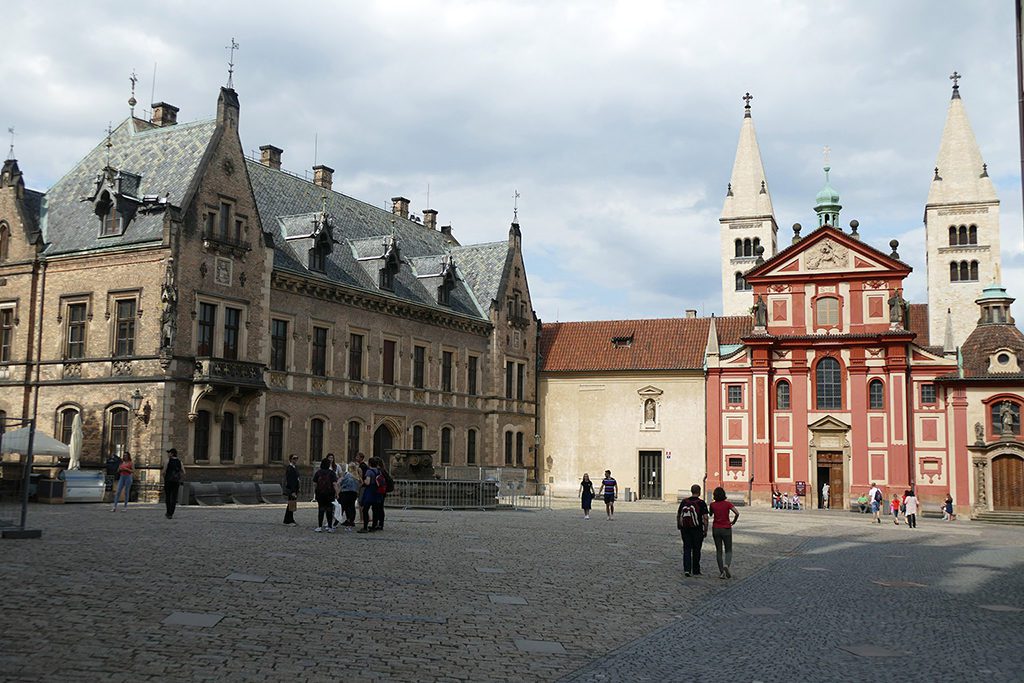
Just like the proper castle, the basilica deems rather sober and austere. This is in stark contrast to all the city’s Baroque and Rococo, obviously.
3. Prague Castle Picture Gallery
I’m a huge art aficionado, so to me, the Castle’s Picture Gallery is a must-see. Here, they display paintings from the famous collection of Emperor Rudolph II. Among over a hundred paintings are also works of Titian, Veronese, and Rubens.
Villas
It’s just terrible: There are so many iconic landmarks in Prague you have to check off your list. And now I’m additionally introducing some off-the-beaten-path-treasures.
Prague’s beauty can be exhausting, we can agree on that.
This walk starts across the road from Letná Park and leads to the posh neighborhoods of Bubeneč and Dejvice North of Prague Castle. Once you walk through the streets lined with incredible villas, it won’t surprise you that many countries chose to install their embassies in these neighborhoods.
1. Vila Bílek
The Vila Bílek is located at one of Prague’s ugliest junctions, across from Letná Park.
It is a two-storey Art Nouveau building that graphic artist, sculptor, and architect František Bílek designed as his workshop and home in 1911.
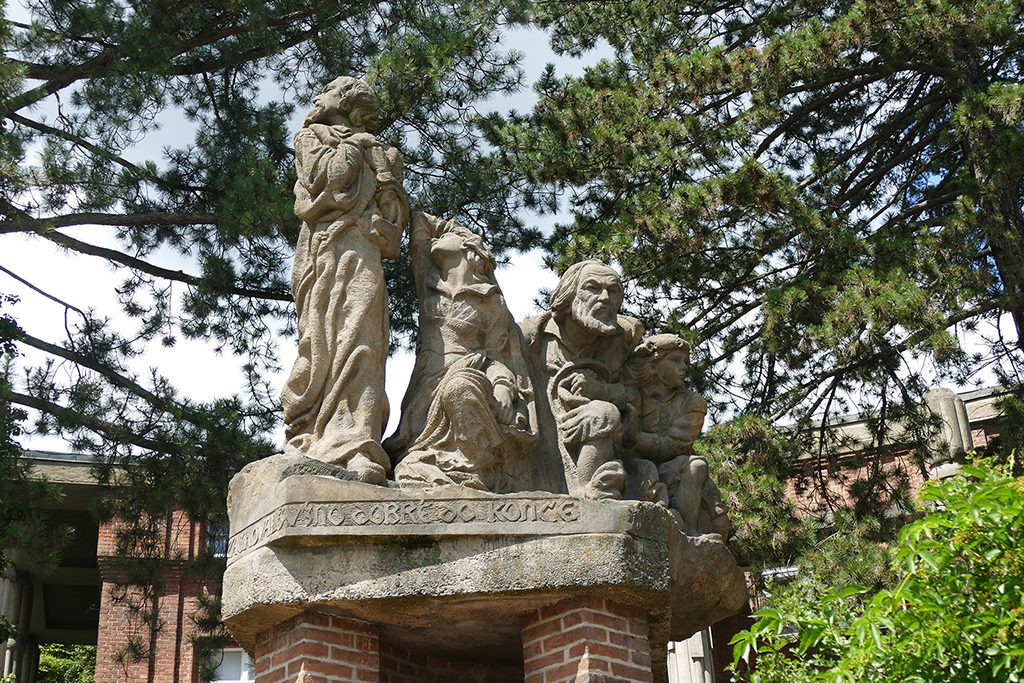
The building depicts the artist’s idea of a cereal field and the layout is in the shape of a scythe. The interiors of the villa are also Bílek’s work.
2. Slavíčkova 9 and 7
Walking from the Vila Bílek further North gets you to the Hradčanská subway station and then across the big ugly road to Prague’s architectural treasure box.
If you need a rest, you can enjoy a snack and a drink at the Vila Pellé. But wait, this actually is another landmark. As I said: Exhausting – but in a good way, of course.
From Vila Pellé you just walk down Slavíčkova street and I promise you, your jaw will drop. The entire street is lined with incredible villas – some of them, however, surprisingly run down.
Říhovsky Villa
Like, sadly, also the magnificent villa at Number 9. It was designed by Gustav Papež for the painter Rudolf Říhovsky in a vernacular style.

The structures are a combination of smooth plaster with gray masonry. However, in addition to the corner rustication and the not very profiled cordon and crown cornice, the building attracts everyone’s attention with the painted floral decoration.
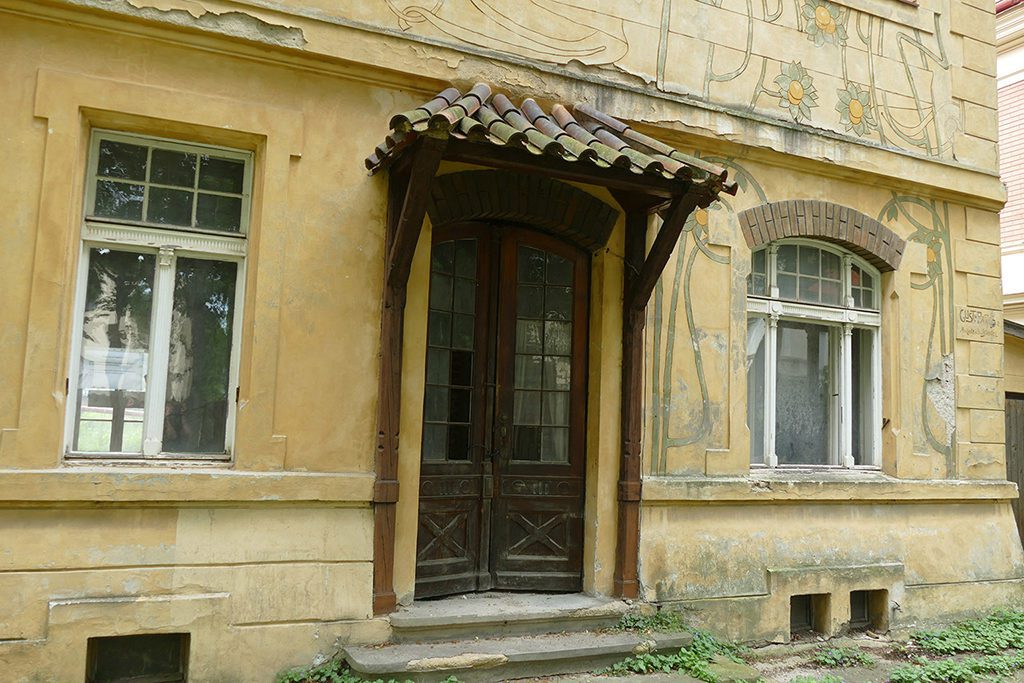
Also, ranges are asymmetrically growing through the facade above the wide window.
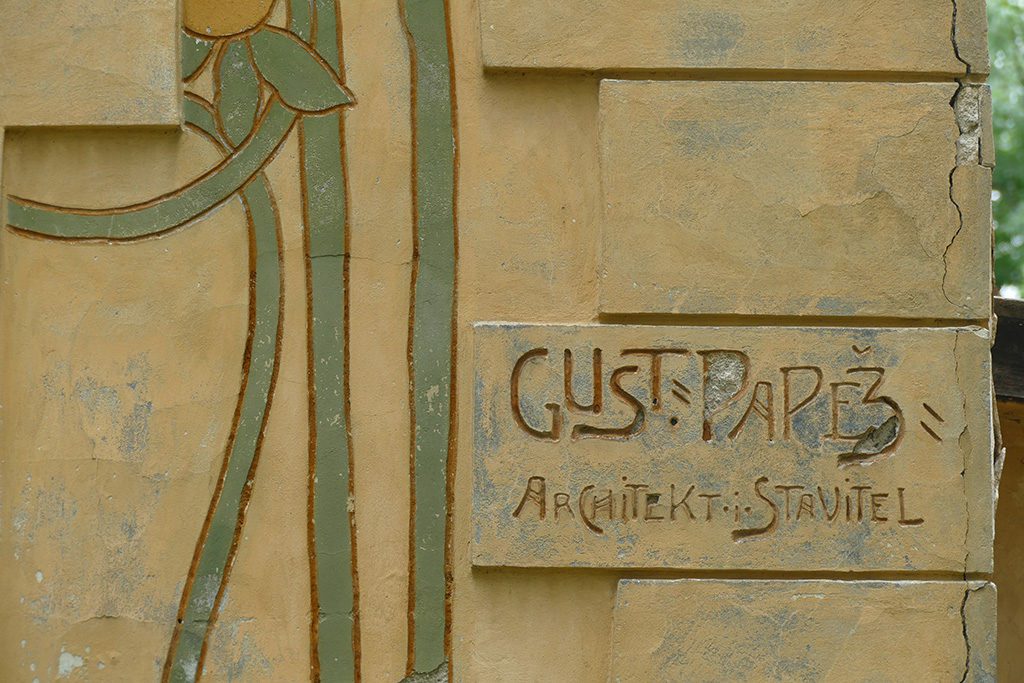
What a masterpiece!
Mašek Vila
Right next door is the villa that painter and architect Karel Vítězslav Mašek built for himself.
It has a complicated floor plan, but relatively simple architectural details.
Its most prominent suit is a risalit on the Northeast corner. Here you see an embossment of the Virgin Mary holding Baby Jesus by sculptor Luděk Wurzl. In the window above you can spot a group of children’s half-figures. The wall is decorated with a grand floral painting. The reliefs to the Madonna’s feet were created by the builder’s Bohumil Waigant’s brother Antonín.

The whole artistic composition deserves a place in a museum instead of being subject to the elements.
Amazingly, all furniture was not only designed, but also manufactured by Mašek himself. This includes all fittings and wood carvings. However, since you cannot visit the house, you have to take my word for it.
3. Governor’s Summer House
According to old records, the manor protected by ramparts was built already in 1261.
Emperor Rudolph II let it be rebuilt in the Renaissance style. However, the present pseudo-Gothic appearance stems from the last reconstruction in 1804.
Today, the archives of newspapers and journals of the National Museum are kept at the Summer House.
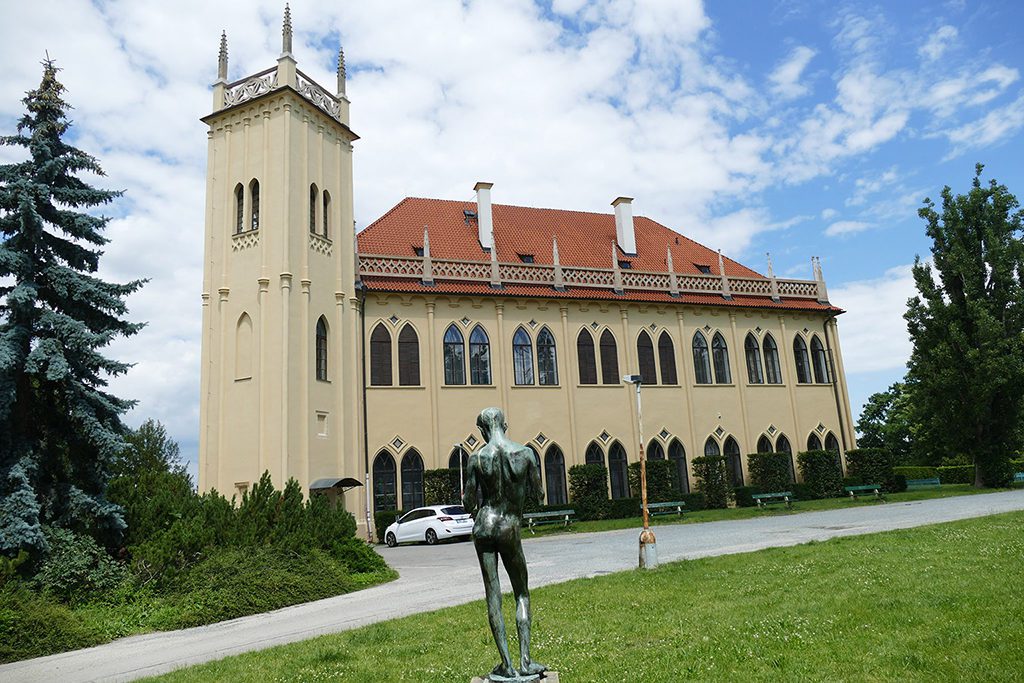
From the summer house’s terrace, you have a grand view of Stromovka Park, the oldest and largest park in Prague. On the other side, on the opposite bank of the river Vltava, is the Troja neighborhood. Here, you can pay Prague’s Botanical Gardens, the Zoo, or the Baroque Troja Castle a visit.
What I particularly love about this park and the adjacent Troja is: It’s very local, you hardly see tourists here.
Museums
1. National Museum
The Národní Muzeum, Prague’s National Museum, is the leading museum in the Czech Republic on cultural and natural history. It has various also historically significant buildings and various vast exhibitions.
The main building on Wenceslas Square houses the archaeological and historical section on the prehistory and early history of today’s territory. Also, there is a mineralogical, a zoological, and an anthropological division.
After a seven-year extensive renovation, the museum was reopened in 2018.

Although most of the interior is from artists who also furnished the National Theater, the building should not only stand out for its monumentality but also for its functionality.
Nevertheless, the entrance hall is adorned with bronze statues of Libuše, Přemysl the plowman, Ottokar II. Přemysl, and Prince Wenceslaus of Bohemia, and famous grounds of Czech history are depicted on the walls.
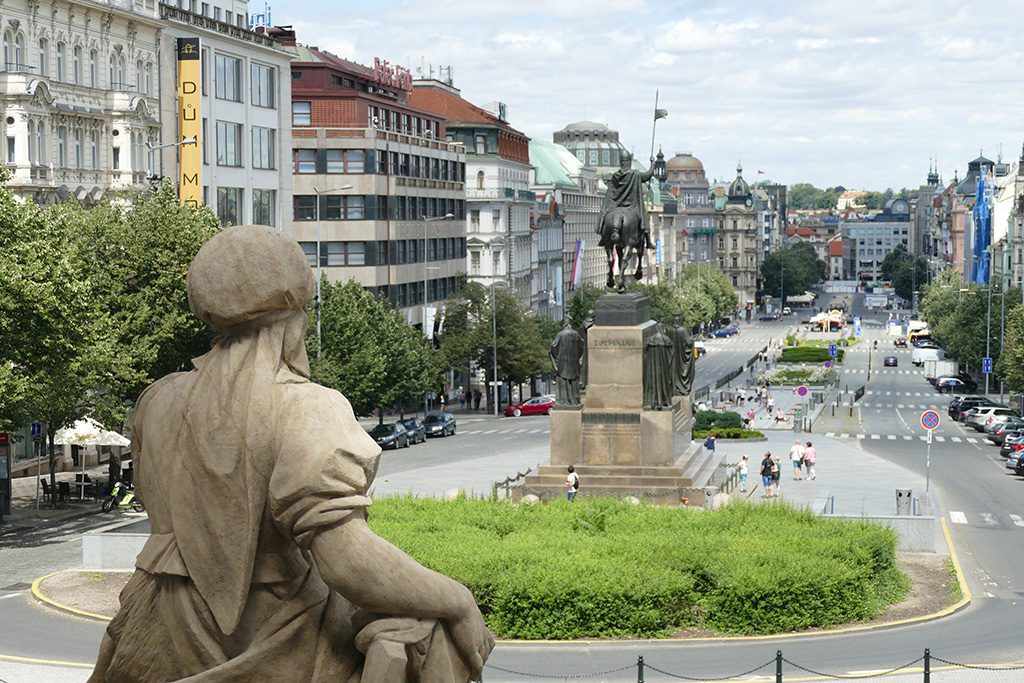
During the invasion in 1968, the front wall of the National Museum was damaged by the Red Army. They mistook the majestic building for the Parliament, the Presidential Palace, or the like.
That was long before google maps, you have to give those Russians that.
2. Schwarzenberg Palace
The Schwarzenberský palác, hence, the Schwarzenberg Palace is a Renaissance structure on my beloved Hradčany Square.
The three-winged building was built between 1545 and 1567 as a city residence for the Bohemian noble family Lobkowitz. It was one of the first buildings in Prague to be built in the style of the Italian Renaissance.

The outer walls are painted with flashy black sgraffiti. Inside, the stairs and the ceilings are richly decorated.
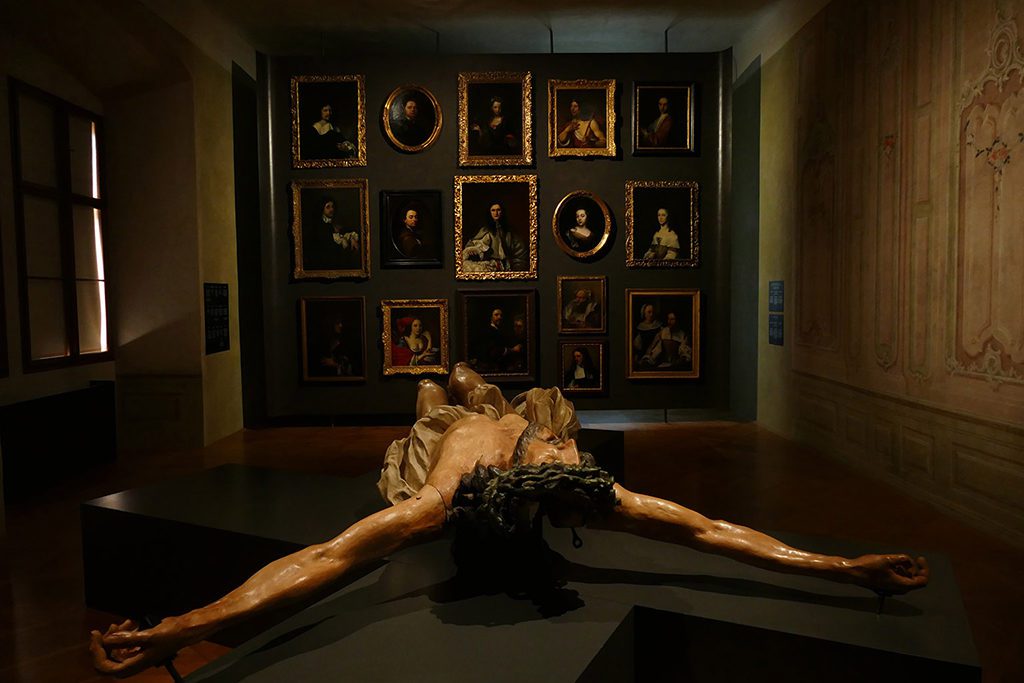
In 1719 the palace became the property of the Schwarzenberg family, who also acquired the neighboring Palais Salm in 1811.
Since 2002, the National Gallery obtained the building so that it now houses the collection of old masters such as Bronzino, El Greco, Goya, and many others.
3. Trade Fair Palace
The National Gallery is by far not one single gallery. Founded in 1796, this art institution owns a fantastic collection of paintings, sculptures, and graphics from the Czech Republic and all over the world.
The collection is presented in many places inside and outside of Prague including the pavilion at the Biennale
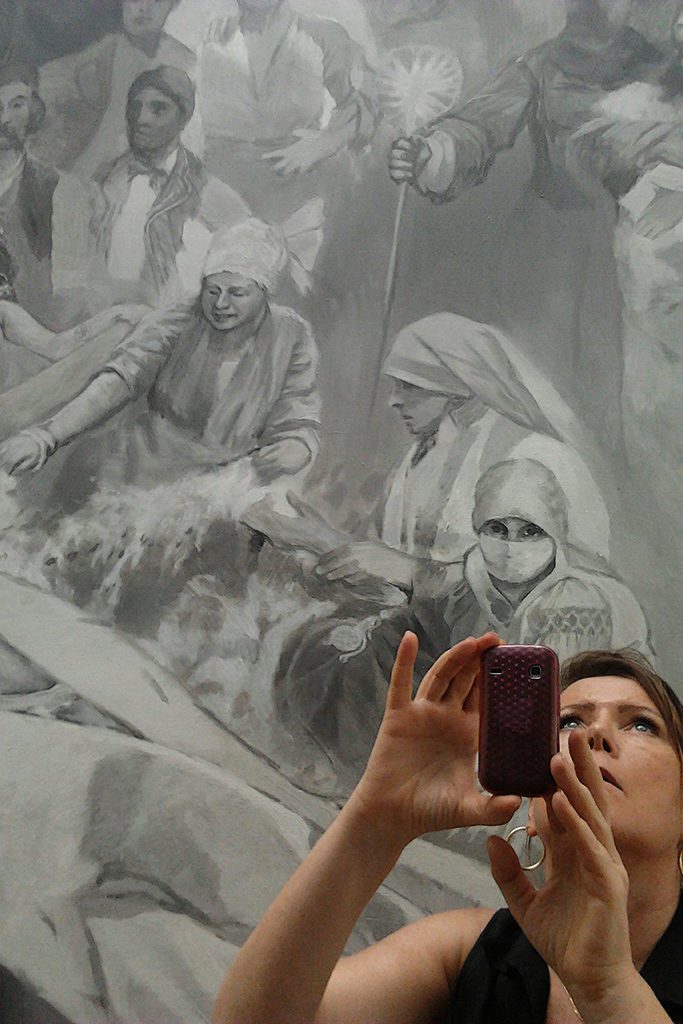
One of the most impressive venues is the Veletržní palác, the Trade Fair Palace. This large building in the Holešovice district Northwest of the city center was designed for trade fairs and exhibitions and built in the years 1925-1928 in a very austere functional style.
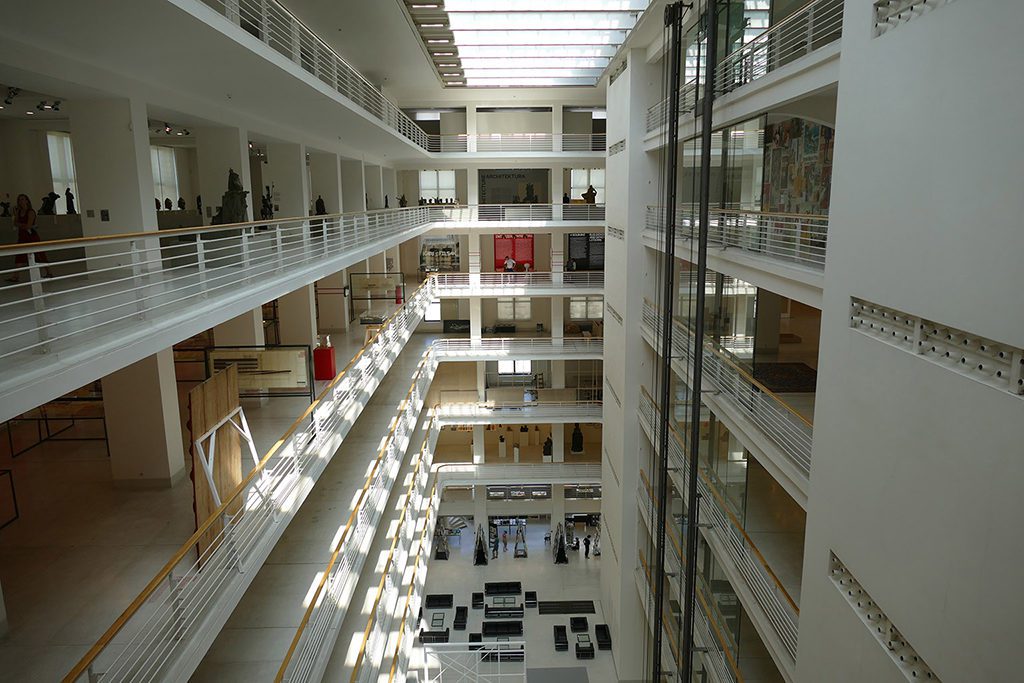
While firstly, the building impressed me with its size and modern design, during WWII it was used by the Nazis for gathering Jews from Bohemia and Moravia for deportation to the concentration camps.
After WWII, it became the seat of foreign trade companies.
As the building burned down in 1974, the National Gallery acquired the remnants.
In the 1990s, the building was reconstructed and since then serves as an art gallery for modern and contemporary art.

Alfons Mucha
1. Mucha Museum
The world-famous graphic artist, illustrator, and painter Alfons Maria Mucha was born in 1860 in Moravia. He is considered one of the most distinctive representatives of Art Nouveau.
On the occasion of the World Exhibition of 1889, Mucha moved from Munich to Paris. There he took lessons from various teachers while he made ends meet by illustrating books. He even shared a studio with Paul Gauguin for a short time.
Designing placards for Sarah Bernhardt, at the turn of the 20th century the best-known actress, helped him to become incredibly popular.
Today, the Mucha Museum provides a complex overview of Mucha’s artistic work. It is housed in the baroque building of the Kaunitz Palace.
2. The Slavic Epic
So while the Museum shows a comprehensive collection of Mucha’s work, one of his most celebrated piece is missing. It is the Slavic epic that I had the chance to see once in Vienna years ago.
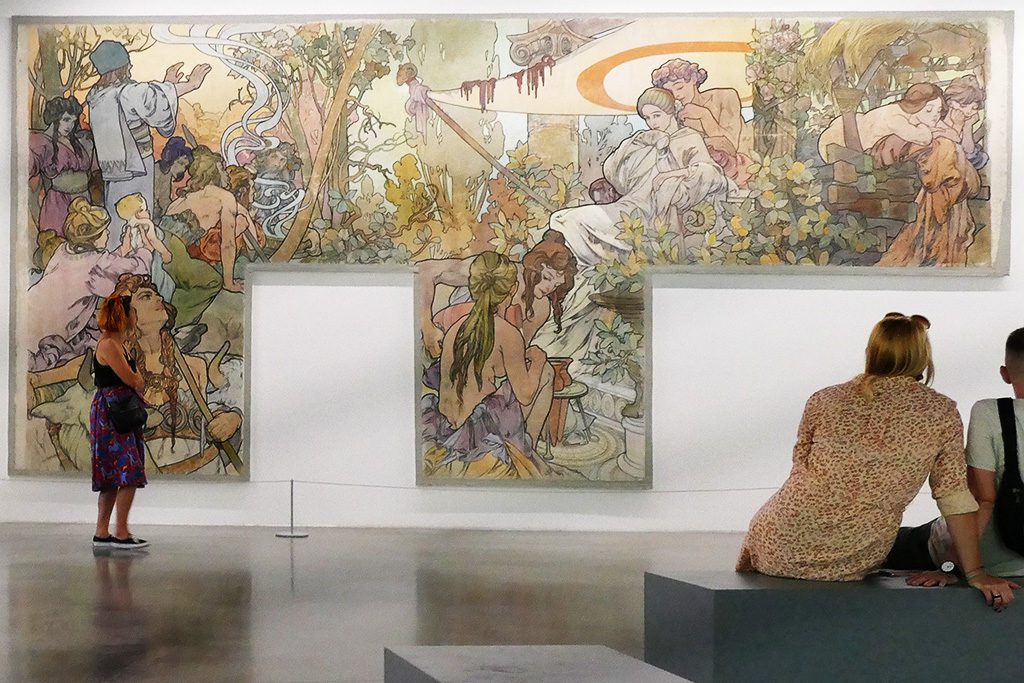
In 1900, at the World Exhibition in Paris, Mucha’s interest in the Slavs was evoked. Later, this led to his main non-commercial work, the Slavic Epic.
It is a cycle of 20 large canvases that Mucha painted between 1910 and 1928. He depicts the mythology and history of Czechs and other Slavic peoples.
Most of the time, this installation is touring the world, so you better check online where it is at this precise moment.
3. Window At The Saint Vitus Cathedral
Another wonderful, very ethnic design by Mucha will never leave Prague. It’s one of the glorious windows at the Saint Vitus Cathedral.
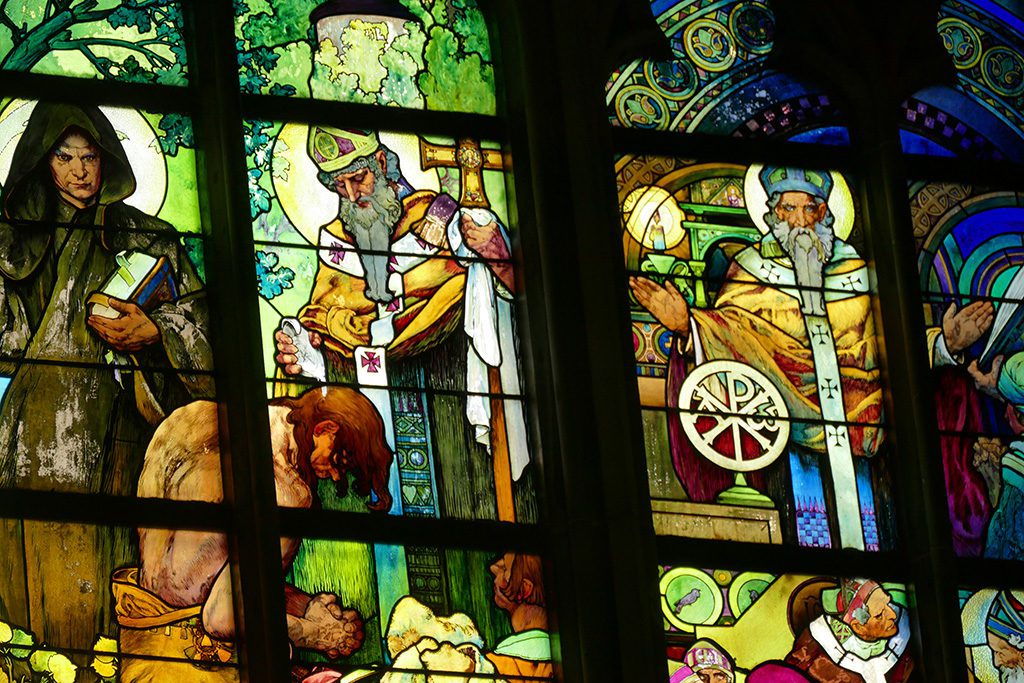
An allegory of Christ blessing the Slavic Nations, the window portrays the boy, Saint Wenceslas, with his grandmother Saint Ludmila surrounded by episodes from the lives of Saints Cyril and Methodius who spread Christianity among the Slavs. This stained glass window was designed by Mucha, completed, however, by Jan Veselý, and installed in the north nave in 1931.
Parks and Gardens
1. Wallenstein Garden
The Waldstein Palace – in Czech Valdštejnský palác – is the largest palace in Prague and is located in the Lesser Town. Today, it houses the seat of the Senate.
The Palace was commissioned by Wenzel Eusebius von Waldstein, better known as Wallenstein. It was built between 1623 and 1630 in the style of early Bohemian Baroque,
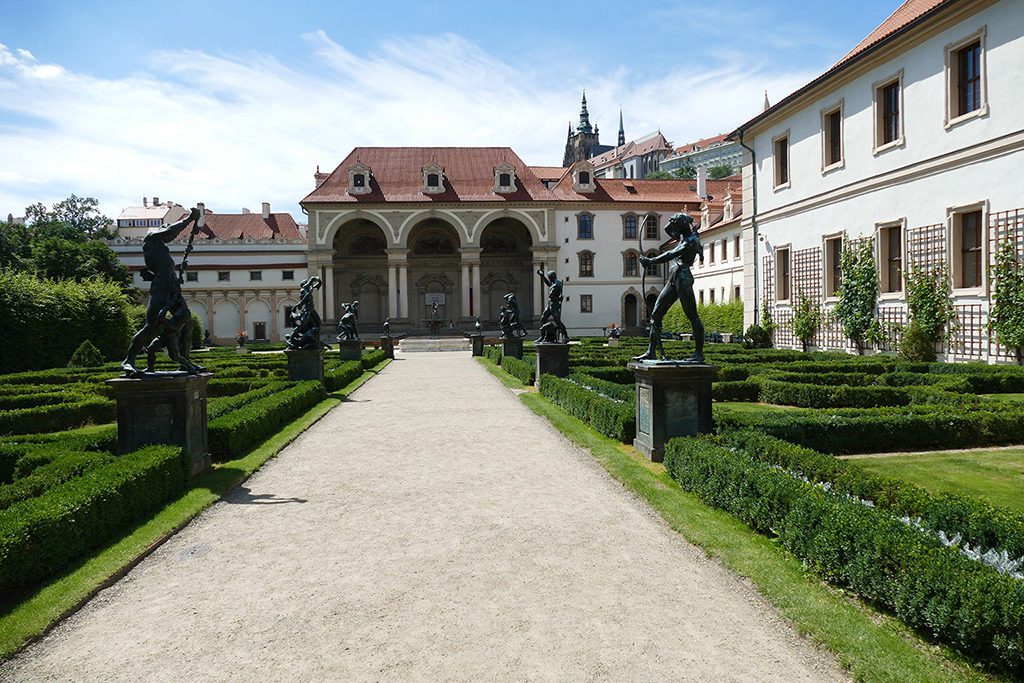
The palace’s strongest suit, however, are the extensive gardens.

A Neptune fountain with bronze figures was built in the garden in front of the loggia, the so-called Giardinetto, in 1626/27.
Later, that fountain was replaced by a fountain originally created for the Lobkowitz Palace with a Venus statue.
Today, casts of the original sculptures are decorating the garden of the Waldstein Palace.
2. Kampa Park
Mostly, this park is referred to as the Kampa island since a creek, the Čertovka or Devil’s Canal, separates it from the mainland of Malá Strana. Honestly, if I didn’t tell you this, you would hardly notice.
Anyway, Kampa Island is one of the most serene spots around Prague’s very center. No wonder it deems so elegantly since the gardens were designed in an English style with lawns and promenades alongside the Vltava and Certovka.
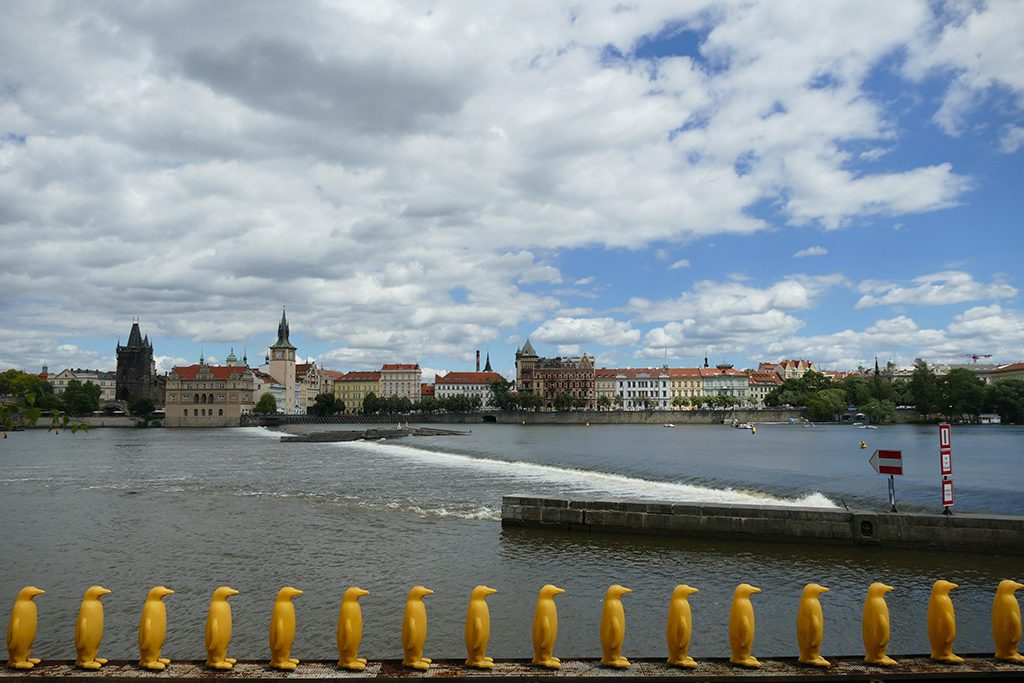
The yellow penguins are a project by Milan-based Cracking Art Group. These cute 34 little fellows are made from recycled plastic bottles and are meant as a warning of climate change.
It’s the perfect place to just relax for a moment and watch the grass grow.
Once you feel rejuvenated again, you might want to pay the Kampa Gallery a visit – I mentioned this venue in the Mucha section. Or you enjoy some refreshments at one of the restaurants on the premises.
3. Letná Park
The Letná Park is a spacious greenery on the left bank of the Vltava. Coming from the old town, prepare for some climbing since Prague’s second-largest park is way up high approximately at the same height as the castle.
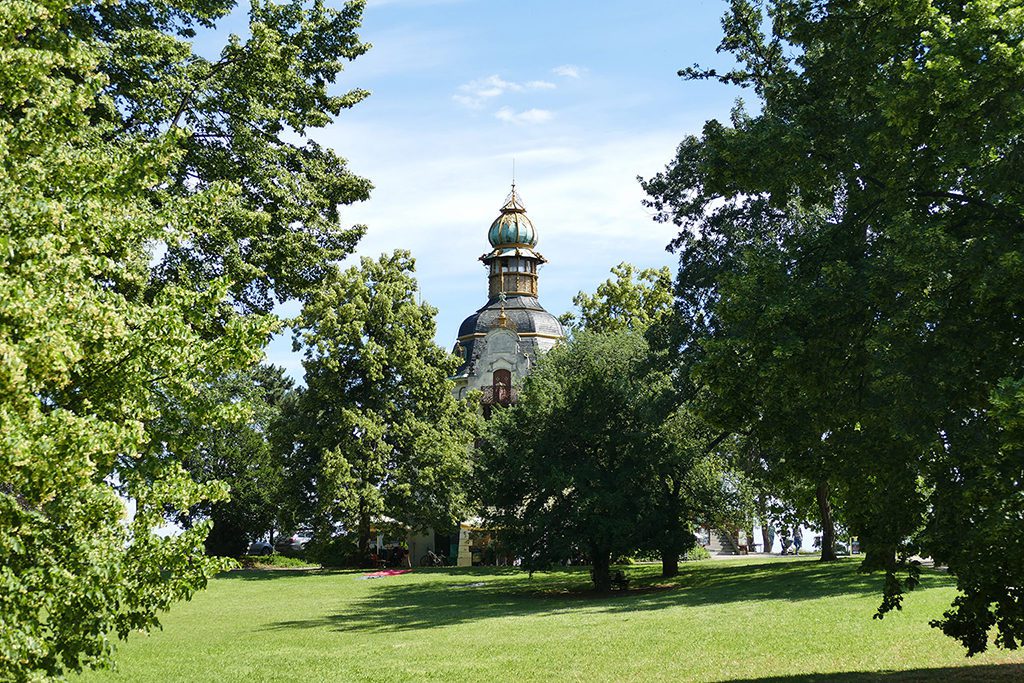
Consequently, thanks to this elevated position, it offers grand views of Prague’s landmarks and the Vltava river with all its bridges.
The greenery was installed beginning of the 19th century.
In 1955, an enormous Stalin monument was erected at the park – overlooking the city from across the Mánes bridge. It was demolished in 1962. Then, in 1991, sculptor Vratislav Karel Novák’s kinetic Metronome was installed atop the massive stone plinth. It’s Prague’s main hangout for rollerbladers and skateboarders – and, obviously, one of the city’s best photo spots.
Jewish Museum
Talking ’bout the Jewish Museum, you shouldn’t figure a single museum building. As a matter of fact, the Jewish Museum in Prague consists of five Synagogues, a Ceremony Hall, an Art Gallery, and the Old Jewish Cemetery. All structures are the well-preserved traces of the city’s Jewish community that had an incredible impact not only on Prague’s cultural life. Immediately Kafka comes to mind.
In case you wonder how these structures survived the Nazi occupation of Prague – it’s actually for a horrific reason. Although the Nazis deported the Jewish population to concentration camps, they didn’t destroy their quarter. They were planning to transform this neighborhood into a museum of the extinguished Jewish race.
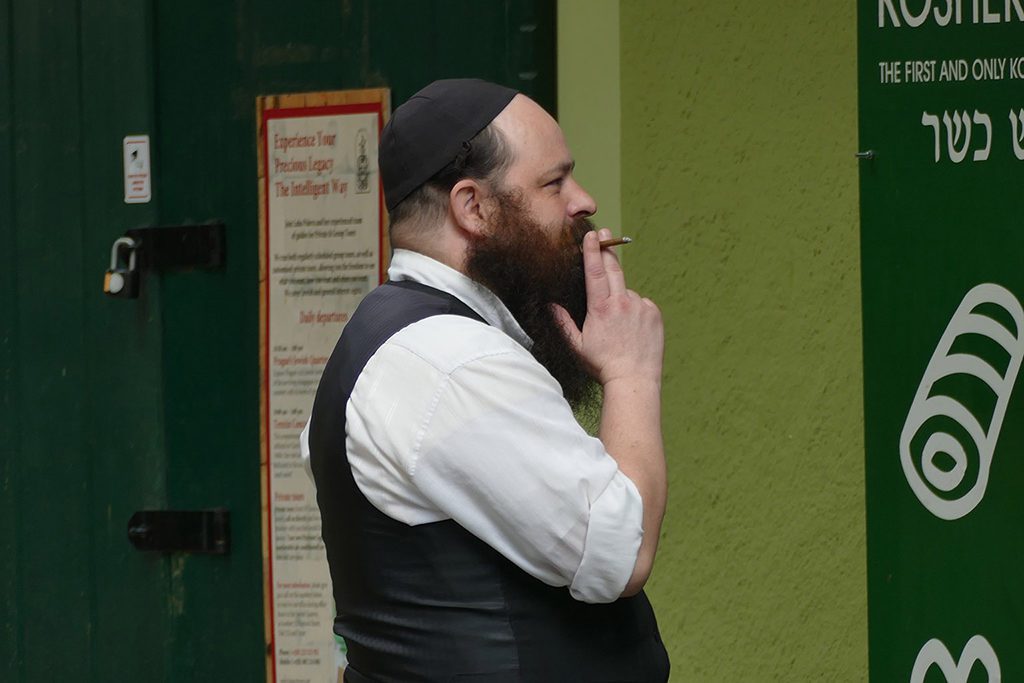
With your ticket, you can visit all the venues that form part of this interesting and beautiful museum complex.
Only the impressive Old New Synagogue is not included – however, totally worth the visit – and the entrance fee is only 100 CZK.
1. Pinkas Synagogue
To recommend a visit to the Pinkas Synagogue is bitter since I’m definitely not sending you to the most joyful of all places.
The synagogue stems from the beginning of the 16th century. However, vaults and a mikveh from the late 15th century were found under today’s structures.

The Pinkas Synagogue of today is so to speak the central point of the Jewish Museum.
In the 1950s, the Torah Shrine, the Bimah, and the Portal were restored. The synagogue was then converted into a memorial for the Czechoslovakian Jewish victims of the holocaust.

The concept of curators Jiři John and Václav Boštik foresaw that the names of almost 78,000 persons are written on the walls of the rooms in alphabetical order, mentioning their date of birth and death. Also, these data are read in a calm, dignified voice from speakers.
It’s a distressing experience.
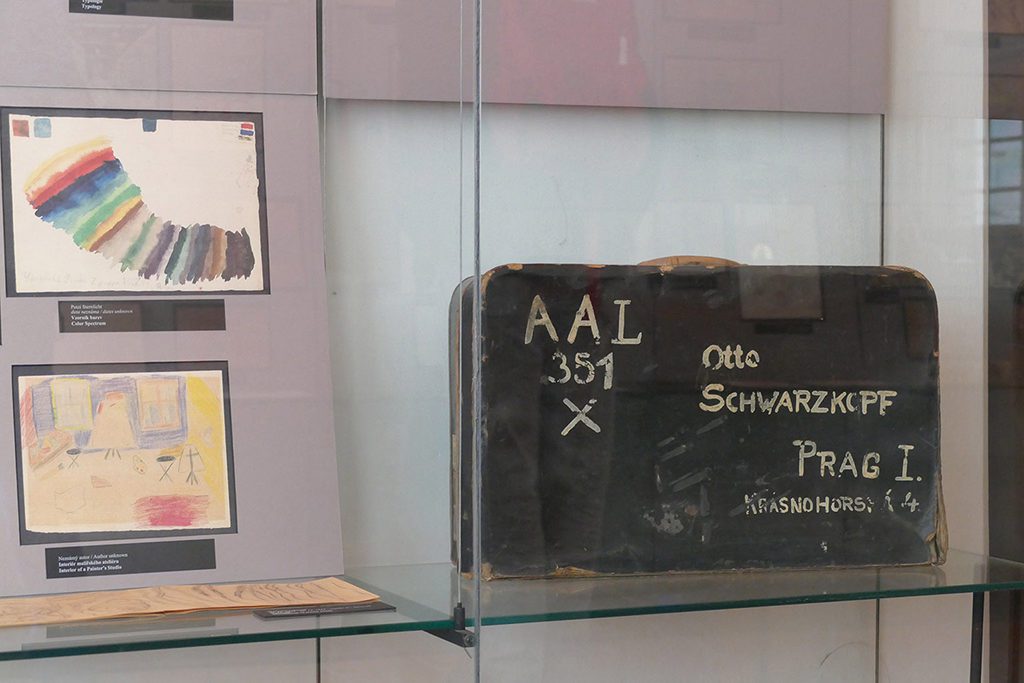
On the upstairs floor is an exhibition of paintings and drawings Jewish children made at the concentration camp of Terezín. You can only imagine under which circumstances these innocent little pieces of art were made.
2. Old Jewish Cemetery
Adjacent to the Pinkas Synagogue is the Old Jewish Cemetery. It is one of the historically most significant Jewish cemeteries in Europe.
Dating back to the first half of the 15th century, it contains more than 12,000 gravestones and probably the remains of 100,000 people. Due to lack of space, the deceased were buried in up to twelve shifts. Over the centuries, this led to an up and down of the earth.

The oldest tombstone from 1439 is one of the writer and rabbi Avigdor Kara. Then, there are also the sarcophagi of Rabbi Löw, creator of the legendary Golem, and patron and rabbi Mordechai Maisel.
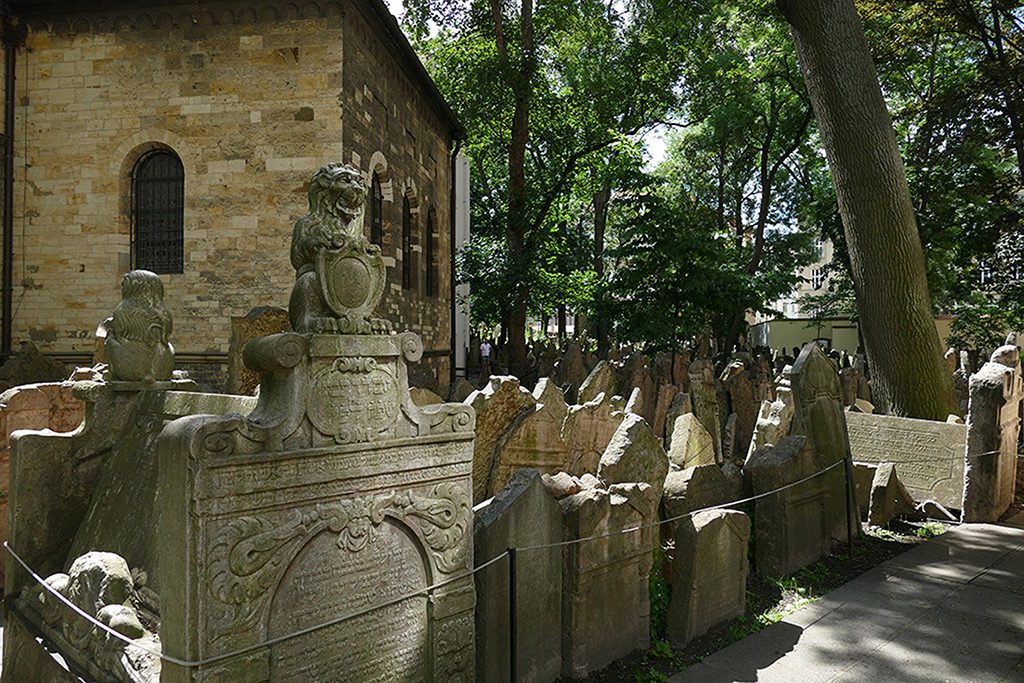
The cemetery lies behind a high wall and is accessible only through the Pinkas Synagogue.
3. Old New Synagogue
As I mentioned above, the Old New Synagogue is not part of the Jewish Museum. However, it can be visited.
It is Europe’s oldest synagogue and one of Prague’s earliest Gothic buildings. Built in the 13th century, it is still the religious center of Prague’s Jewish community.
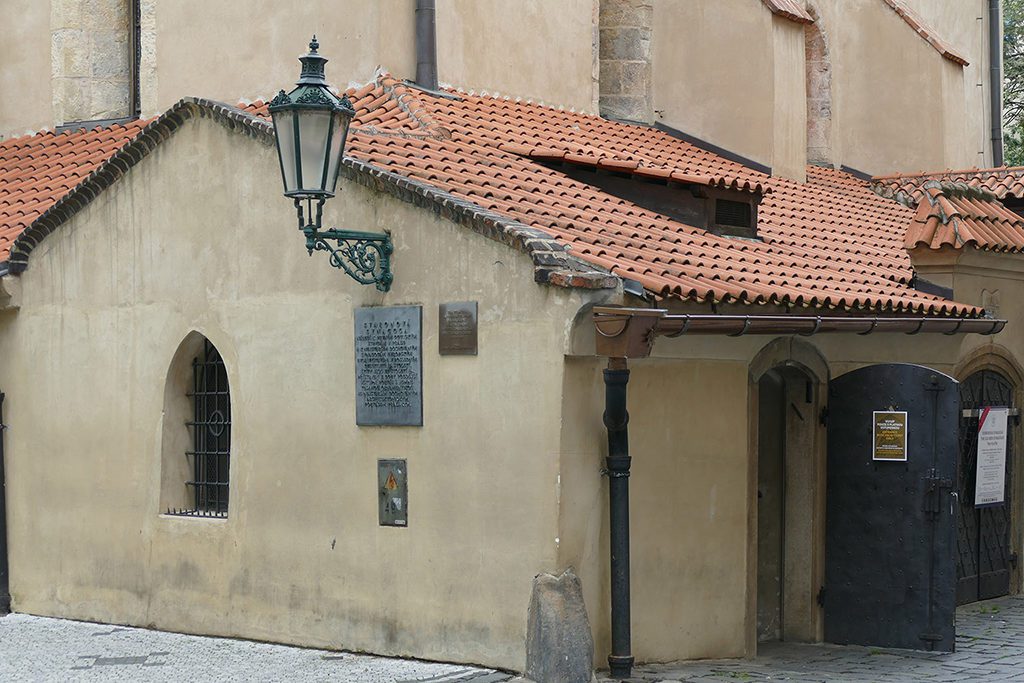
This house of worship has always been the main center of the Jewish community with famous rabbis such as Eliezer Ashkenazi and, of course, Rabbi Löw.
In addition to the High Synagogue and the Jerusalem Synagogue, the Old New Synagogue is one of the three synagogues where religious services are still held. That’s also the obvious reason why it’s not part of the Jewish Museum.
Franz Kafka
1. Statue of Frank Kafka
In 1883, Franz Kafka was born in Prague into a Jewish family. At that time, Prague was part of the Austro-Hungarian Habsburg Empire in Bohemia, where numerous ethnicities and languages mingled and coexisted. Kafka’s family belonged to the germanophone minority. Nevertheless, the family also spoke Czech.
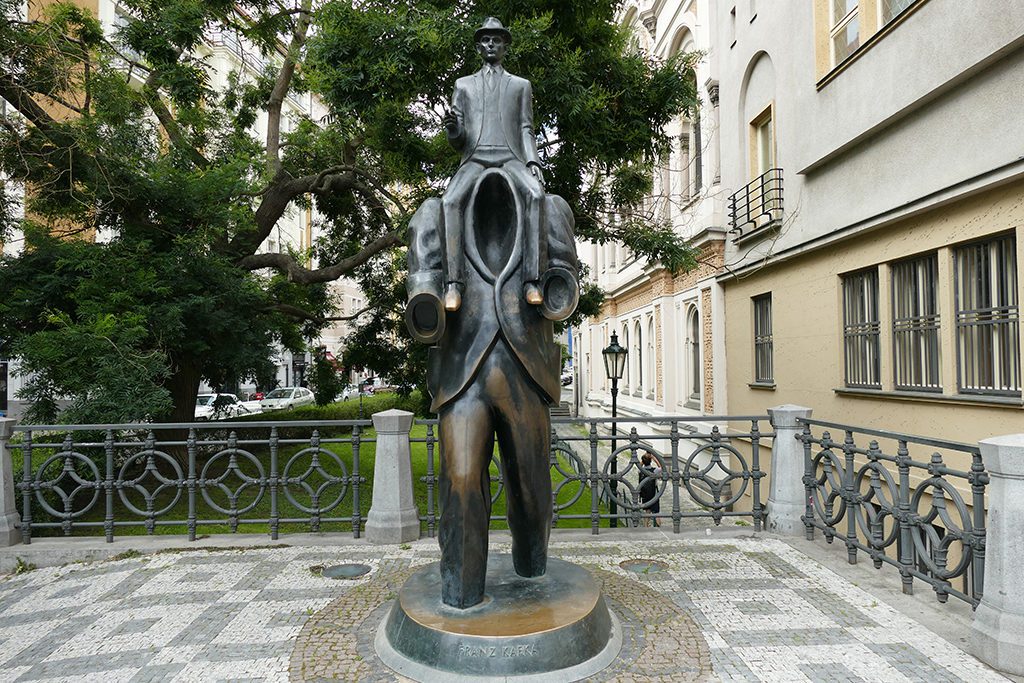
It was not easy for Kafka, a native Bohemian of the German language, actually neither Czech nor German, to find a cultural identity.
Referring to my personal story that I sketched at the beginning of this post, I totally feel him.
2. Head of Franz Kafka
Although Kafka was employed at a semi-public insurance company – which he often described as his bread profession – he became one of the most famous German-speaking writers.
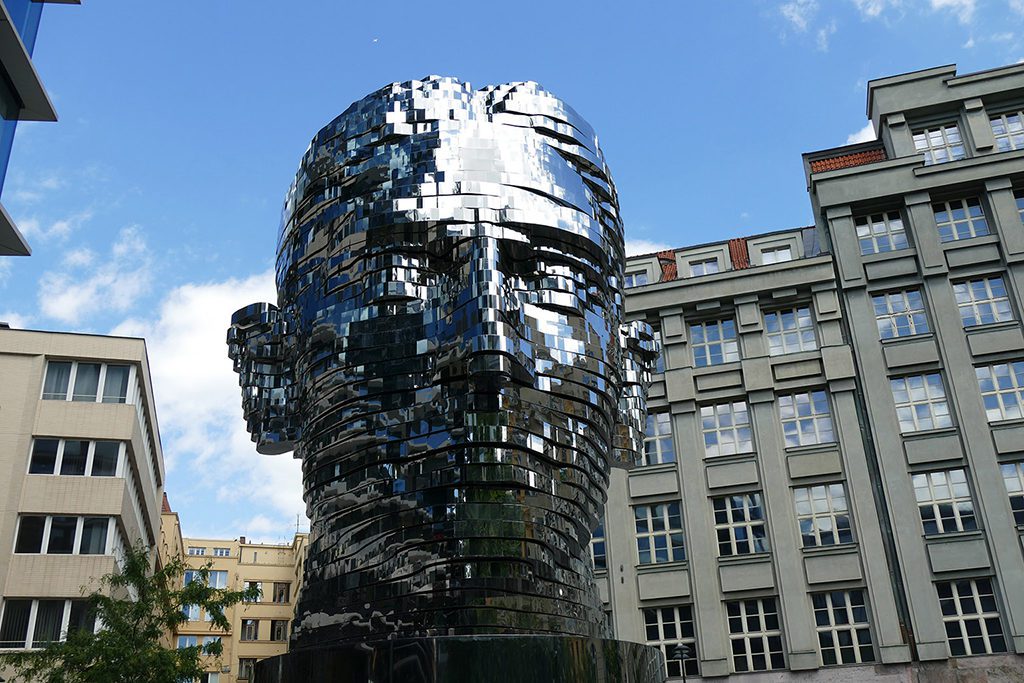
However, for the most part, Kafka’s work was published after his death and against his last will by his close friend Max Brod.
3. Franz Kafka Museum
Everything about Franz Kafka’s short life – he died at age 40 from the consequences of a tuberculosis infection – is at this museum located on the Western bank of the river Vltava.
The museum houses a number of first editions of Kafka’s books as well as letters, newspapers, and drawings created by the writer.
And this brings us to the next artist whose sculptures often deal with Franz Kafka. It’s Mister…
David Černý
52-year-old sculptor David Černý is Prague’s enfant terrible as well as a superstar.
His quirky and provocative sculptures are not only scattered all over Prague, but are also exhibited at international art shows like for instance the NordArt in Northern Germany.
1. Piss
David Černý created some well-known sculptures in Prague such as the crawling toddlers on the columns of the television tower.
In the courtyard of the Kafka Museum, however, he lets two men urinate in a basin the shape of the Czech Republic.
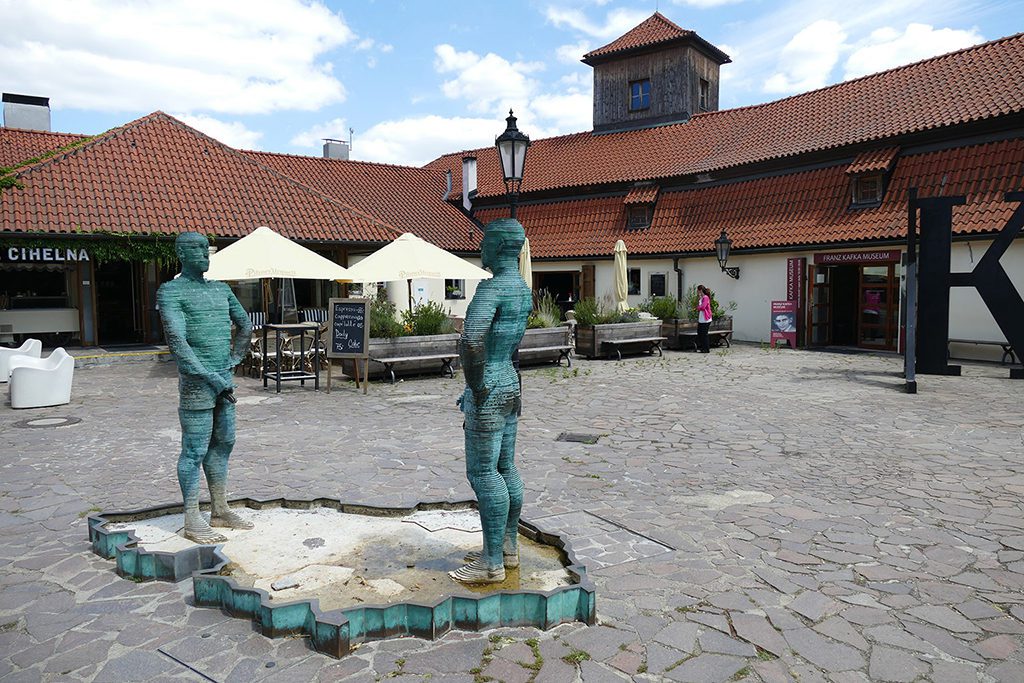
Those men consist of layers – just like Kafka’s head in the above section – and can move their hips. This enables visitors to determine what message these men wee into the water via text. The gsm unit inside the sculpture receives these SMS messages that have to be sent to the number that you find close to the statue.
2. Saint Wenceslas on the Dead Horse
In 1999, David Černý created this wryly amusing counterpart to the equestrian statue of Saint Wenceslas in Wenceslas Square. Here, Saint Wenceslas sits astride a horse that is hanging by its hooves, being decidedly dead. Although it looks quite massive, it is actually surprisingly light since it was made from polystyrene foam.

The statue is installed in the passage of the Lucerna Palace near the entrance from Vodičkova Street.
Although Černý never comments on the meaning of his works, it can be assumed that this Wenceslas – which translates to Václav – is a reference to Václav Klaus, president of the Czech Republic from 2003 to 2013.
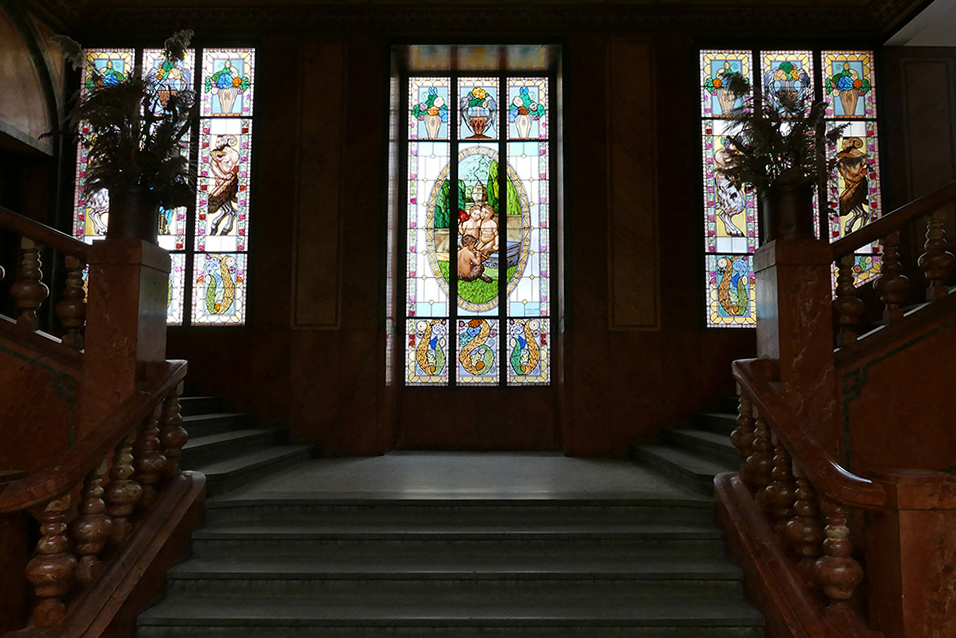
However, according to a written agreement between the owner of Lucerna Palace and David Černý, the sculpture will hang in its place until the constitutional monarchy is restored in the lands of the Czech Crown.
Wink, wink.
3. Man Hanging Out
One of Černý’s most instagramable works is probably a man hanging from a rod above the Husová.
It is a statue of Austrian psychoanalyst Sigmund Freud. He’s hanging there by one hand, pondering whether to let go.
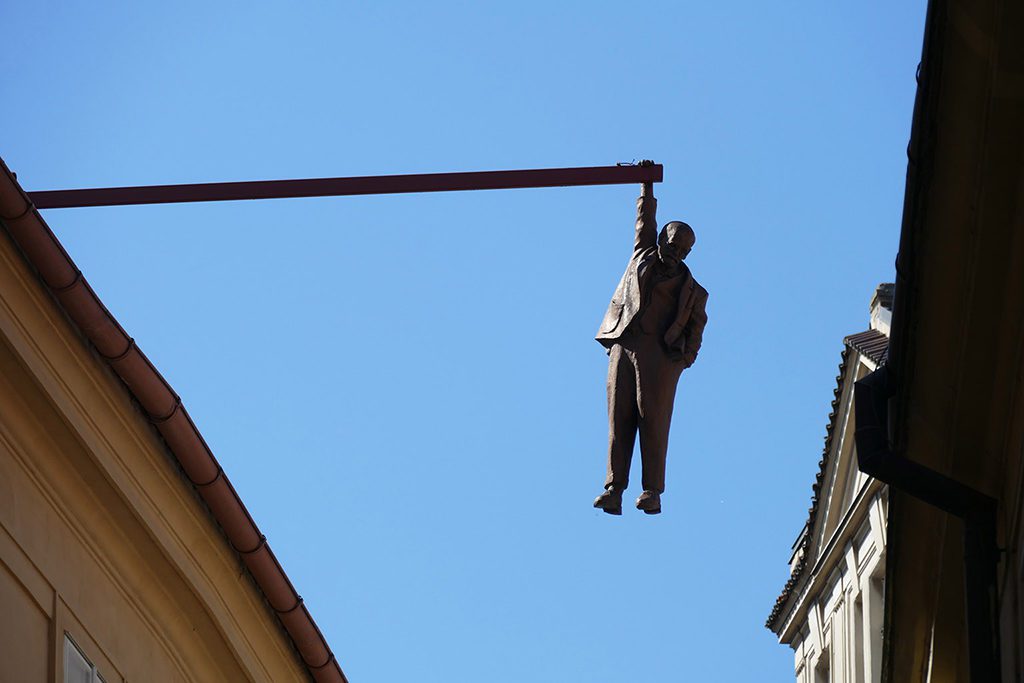
Sigmund Freud was born to Galician Jewish parents in Příbor which at that time was part of the Austrian Empire. Černý depicts Freud in this way to signify his constant struggle with fear of death. And as a matter of fact, as the father of the psychoanalysis suffered from mouth cancer, he had his close friend and doctor help him to commit suicide by administering morphine.
This sculpture became so popular that it was also exhibited in London, Berlin, Rotterdam, Chicago, and other cities.
Fun fact: Often mistaken for a real suicide attempt, the sculpture has alarmed police and firefighters.
Panoramic Viewpoints
1. Vyšehrad
Prague is surrounded by hills which makes exploring the city a bit more exhausting. But while in other cities you have to climb on some towers’n’skyscrapers, in Prague, you just walk up that hill and the entire city lies to your feet just as if she had waited for you to get your camera ready.
One of the most interesting sites to visit a bit on the outskirts of the actual city center is Vyšehrad.

Vyšehrad is one of the most famous early medieval castle walls in Bohemia. Founded as the second Prague Castle of the Přemyslids in the 10th century, it was expanded several times in the Romanesque and Gothic periods.

Inside the castle are the St. Peter and Paul Church and the Vyšehrad Cemetery with the graves of numerous artists, scientists, and politicians.

Be prepared that visiting Vyšehrad is really exercise since it’s located on a quite steep hill.
However, the premises, as well as the views, are totally worth the effort.
2. Strahov Garden Viewpoint
As already mentioned above in the section on monasteries, just below the Strahov Monastery is a specious, open viewpoint. From here, you gave a grand view of the city and gardens below.
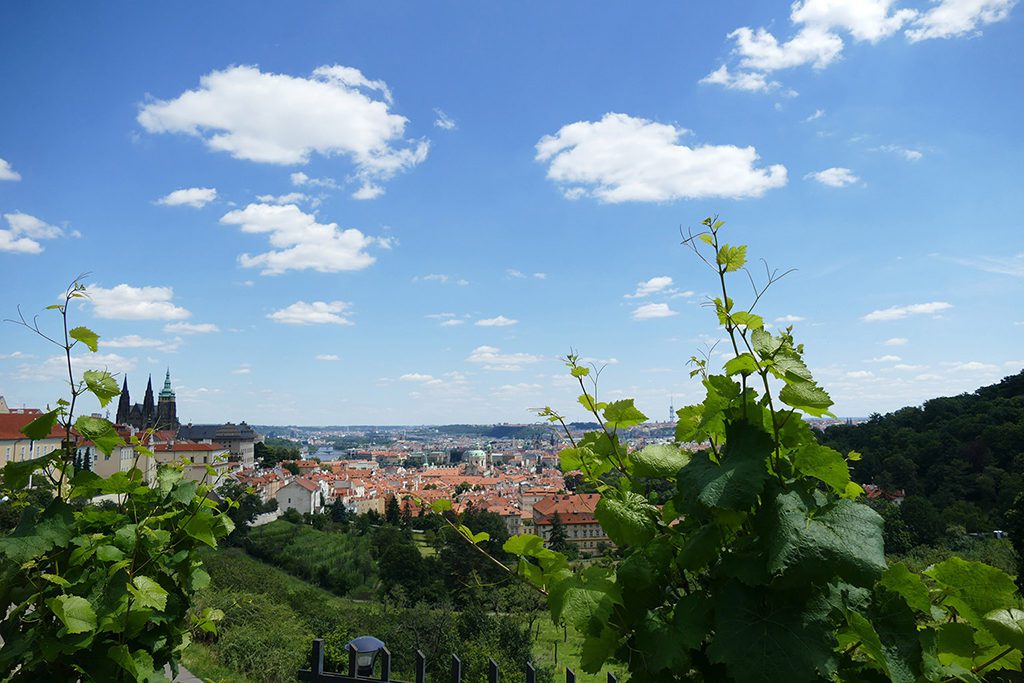
I actually loved capturing a bit of foreground foliage in some of my shots. I find they give the pics a charming, a bit rural atmosphere and, visually, more depth.
3. Letenský Profil
I’ve introduced Letná Park in the section on gardens and parks above.
Hence, after crossing the Mánes Bridge and climbing up the stairs to the Letná, first catch your breath and then walk a few steps to the left.

There you will see various more or less open terrains from where you get to see both banks of the Vltava river from different angles.
Practical Information
How to Get There
By Plane
In 2012, the international airport in Ruzyně was renamed Václav Havel Prague Airport. It is located about 15 kilometers west of Prague’s city center.
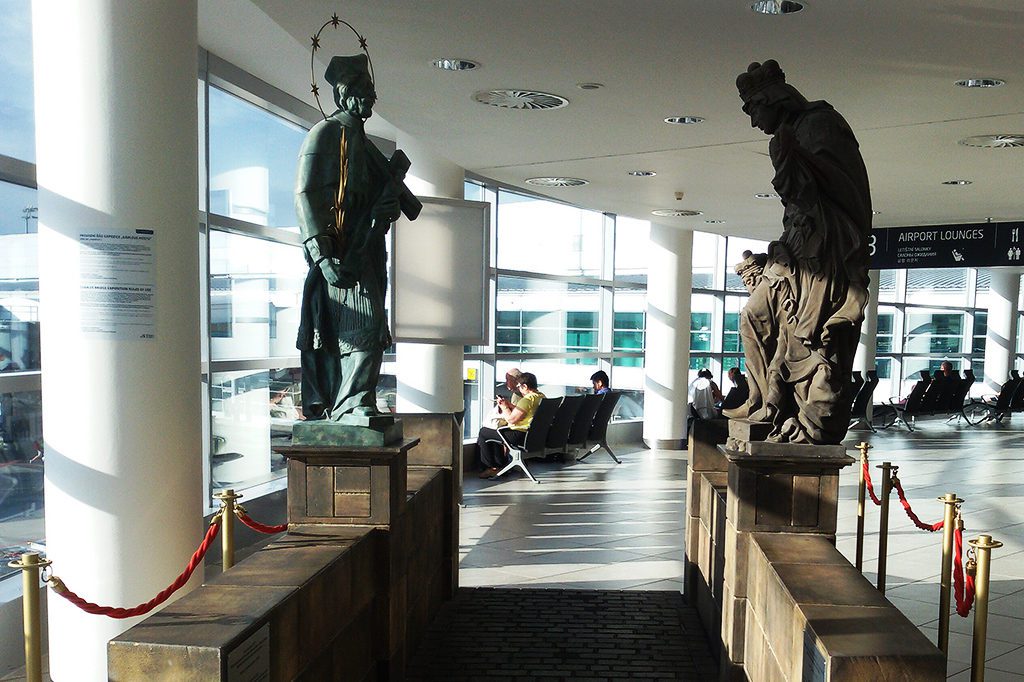
Bus #119 travels between the Nádraží Veleslavín station of the subway line and the airport every five to ten minutes. Also, bus #100 travels between the airport and the Zličín station of subway line B. For both, you only need a regular ticket.
You can buy your ticket at the Public Transport Information Centre in the airport building, from the ticket machines by the exit doors, and at the bus stop. In this case, you pay 32 CZK. If you buy your ticket from the driver, it will cost you 40 CZK and you’ll need exact change.
An Airport Express bus shuttles every half hour between the airport and Prague’s Central Station.
At night, the airport is served every 30 minutes by bus #910 bus.
However, for your safety, here you can pre-book a reliable and reasonably priced airport shuttle.
By Long-Distance Bus
Travelling by long-distance bus is getting really popular in Europe. The cheap prices make up for the little loss of time compared to trains. And since various companies are competing, the service is usually very reliable.
One of the most popular bus companies in Europe is flixbus. They are going to Prague from many European cities like for instance Berlin, Vienna, Warsaw, and many others.
There are about 450 daily connections from the huge, modern bus terminal Florenc east of the old town. The terminal has everything you need for a comfortable and safe trip. Check out their excellent website for further information.
By Train
The Czech Republic lies in the center of Europe and can therefore easily and quickly be reached by train. Obviously, mainly from neighboring countries like Germany and Austria. But even from Paris, you get there in about 14 hours.
You can check connections and buy tickets at the online shop of České dráhy, the national train company. Don’t worry, besides in Czech, you can check – pun intended – their site also in English or German.
How to Get Around
Walking
During the three days that I spent in Prague, I walked far too much. But the city is so beautiful, the sun was shining, what better way of exploring than walking?! Nevertheless, in the evening, after an inspiring yet exhausting day, I was more than ready to soak in the hot bathtub of my comfortable suite at The Emblem Hotel.*
Then, ladies, make sure to wear flat, comfortable shoes. Prague’s streets are paved with cobblestones. Hence, there go your heels.
Also, Prague is hilly. While walking uphill can be exhausting, walking downhill can be even more dangerous if your soles are slippery. Good sneakers or even hiking shoes will make your exploration of Prague safe and enjoyable.
Public Transport
However, there is a comprehensive network of public transportation. The most important means are the metro, trams, and buses. Clicking on these words will open the respective systems maps.
Also, there is a funicular going up and down between Ujezd and Petrin.
You can buy a ticket for 30 and for 90 minutes for 24 respectively 32 CZK, children between 6 and 14 pay half, under 6, they ride for free.
There are also passes for one day, three days, and a month that cost 110, 310, and 670 CZK.
You can purchase tickets at metro stations, kiosks, Public Transport Information Centres, and vending machines at major tram and bus stops.
Once you have purchased a ticket, you have to validate it at the moment you travel. You do that at one of the machines located at the entrance to the metro or inside trams and buses.
As I took the tram, there was only a machine that I did not understand – which was not a language issue – and people weren’t able to explain what I had to do – and in the end, I just didn’t pay at all.
Therefore, I suggest you go to one of those Public Transport Information Centres and ask them what exactly you have to do; if you actually intend to travel that much.
Where to Stay
Prague is one of the most touristy cities in Europe. Obviously, there is a wide choice of accommodation. Besides big, modern, and luxurious hotels, there are many smaller, rather cozy, and romantic guest houses and B&Bs.
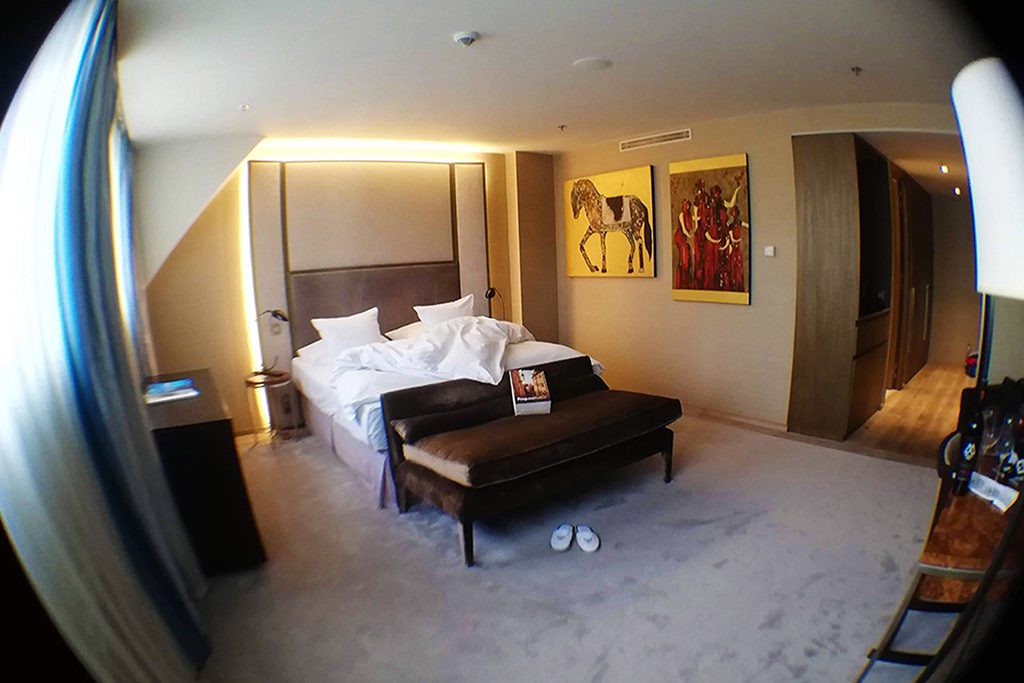
I spent my three nights in Prague at one of the most convenient locations. The Emblem Hotel* is located about two minutes from the Old Town Square and about five minutes from the Charles Bridge as well as the Jewish Quarter Josefov. It cannot get more convenient.

Despite its perfect location, it is very quiet. Honestly, it must be horrible staying right at the Old Town Square when you’re not at a Steg or Hen Party in Prague.
Location, Location, Location
Since I visited Prague to explore the city – and I did it walking – I was very happy being able to just crash close to the most important landmarks, however, not right next to them.
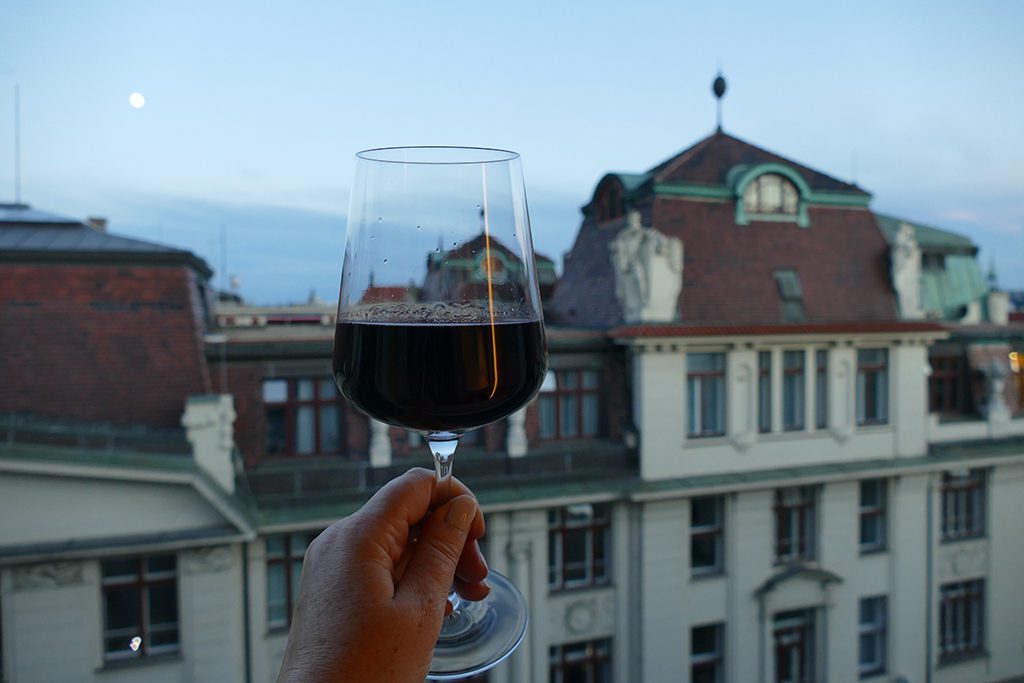
The stay at The Emblem Hotel* was absolutely wonderful. A huge, comfortable bed with the softest crispy clean bedding. A minibar with drinks and snacks, but also a complimentary capsule coffee machine and tea maker with assorted teas was at my disposal.
If you like to watch TV before you doze off, you can watch channels from different countries in the original language on a big flatscreen TV.

When I was there, unfortunately, they were renovating their SPA which is located on the 7th floor. Hence, relaxation with a view. However, I had a spacious and elegant bathroom with a big tub, so I made my own SPA.
So I hardly see a better price-service ratio in such a touristy and busy city like Prague than the cozy oasis that is The Emblem Hotel*.
You can check their availability and rates here.*
In case The Emblem Hotel* is booked out, you can check out other convenient lodging options on this map*:
Booking.comWhere to Eat
Traditional Bohemian cuisine is very tasty, nevertheless really heavy. Due to the mutual past, it is similar to Austrian and Hungarian cuisine. As a matter of fact, wealthy Austrian families often hired cooks from Bohemia during the Austro-Hungarian era.
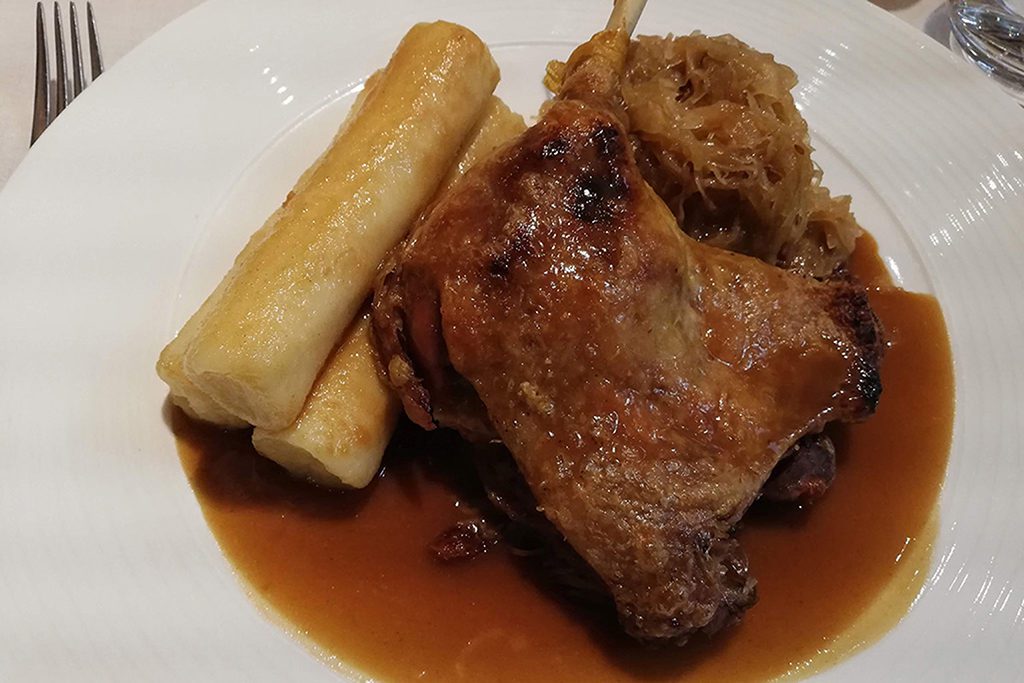
Among the most popular dishes are meats, especially pork. And as if all those pork isn’t heavy enough, it’s accompanied by dumplings.
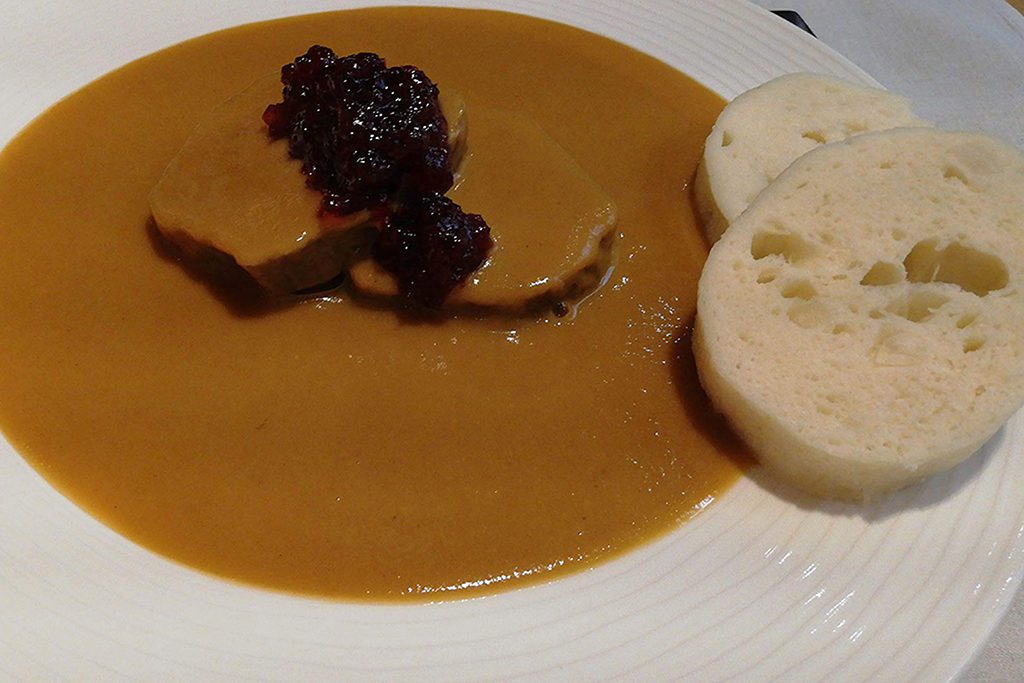
Vegetables are used rather sparingly. Sauerkraut or freshly cooked white or red cabbage is often a vegetable-like side dish.
All this, of course, is the traditional cuisine. Obviously, there are international restaurants in Prague, too, as well as eateries where you get lighter food including salads.
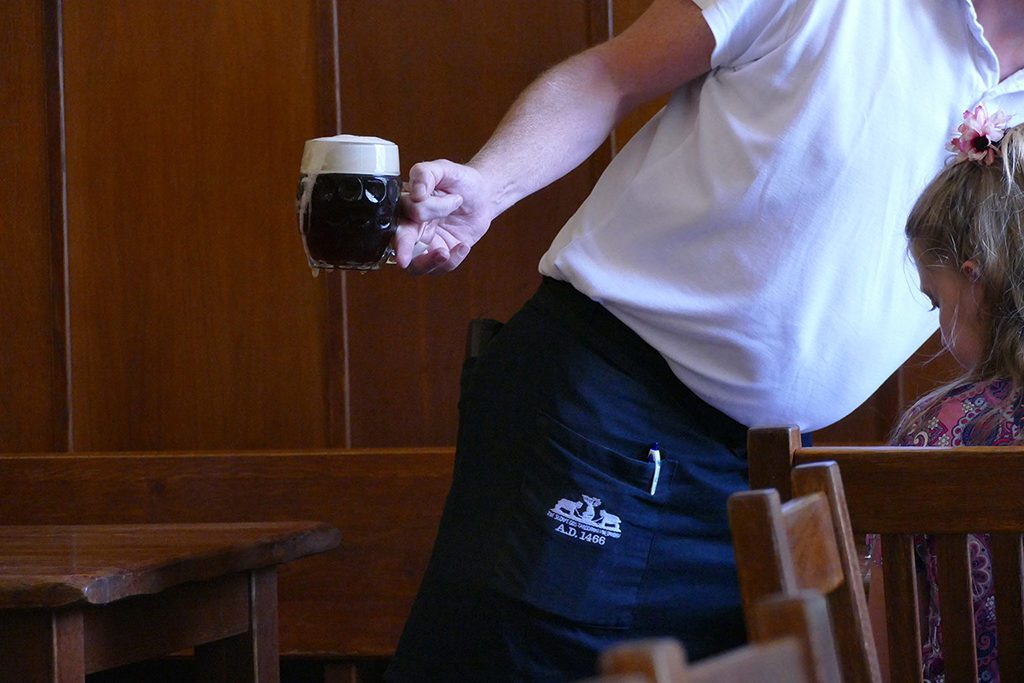
However, while in Prague, you should try at least once one of these fantastic feasts.
Wash it down with the world-famous Czech beer – and the traditional bitter Becherovka will help you digest it.
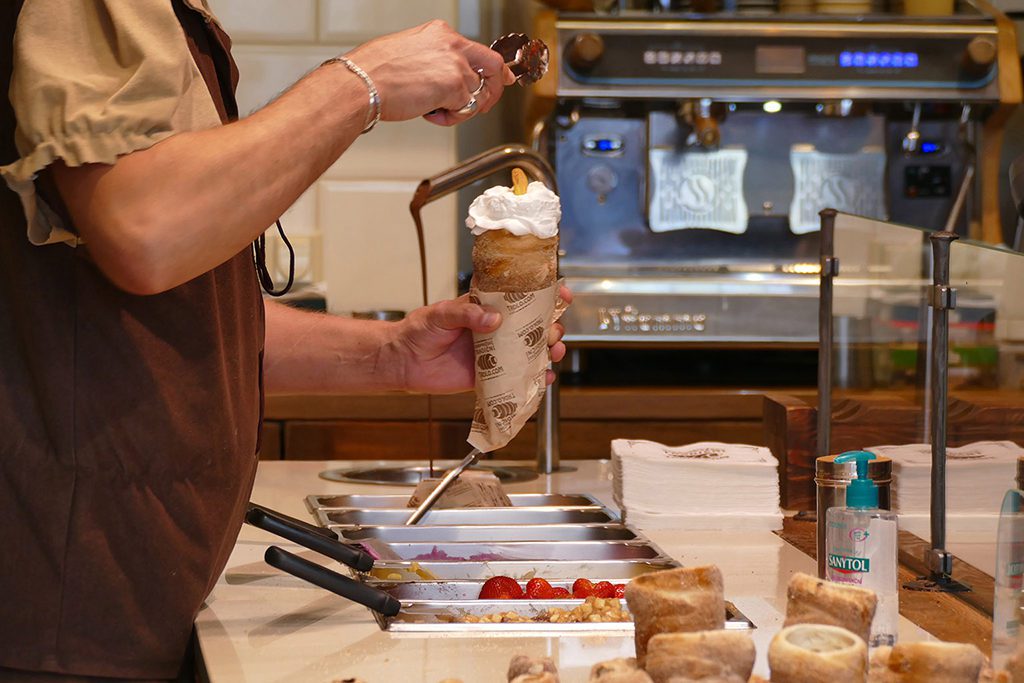
After all, you still need room for dessert. Here, too, Bohemian pastries had a great influence on Austrian cuisine. So you get all those Strudels and – my favorite – fruit-filled dumplings.
What to See
I’m an avid solo-travelling woman. Since solo travel doesn’t equal solitude, I love to join organized tours here and there. They allow me to meet fellow travellers – for just a short moment or a lifelong friendship.
Especially if you have only a short time for exploring Prague or want to explore some unbeaten paths, an organized trip will enable you to make the best of it*:
Cash And Cards
Although the Czech Republic has been a member of the European Union since 2004, they do not pay with €uros.
The Czech crown has been the currency of the Czech Republic since shortly after the division of Czechoslovakia in 1993. One crown is divided into 100 hellers. However, in stores, they just round prices up most of the time.
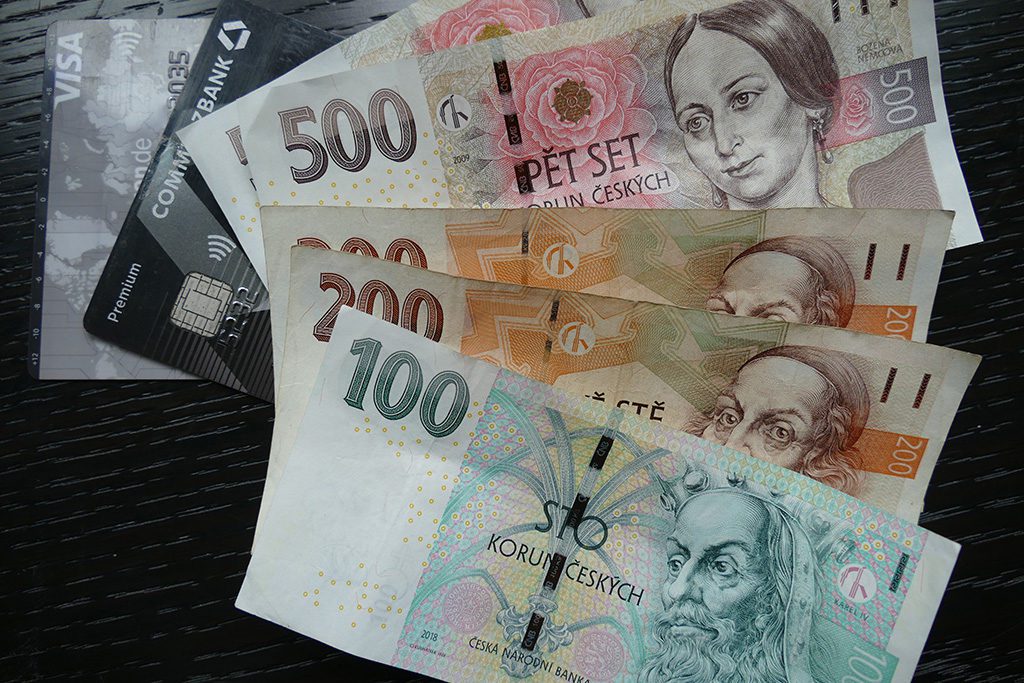
And now you probably want to know how much these beauties are in other currencies. So, 1 US$ equals 24.63 CZK respectively 1 €uro 24.60 CZK (as of August 2022). Yet, here you can check the current rate to the US$ and to the €uro.
Language
I am so happy having learned Czech as my mother tongue. It must be so frustrating learning it as a foreign language. Maybe that’s the reason why so many Czechs speak at least one foreign language pretty well. In the past, they had to learn Russian at school, however, due to Stalinism and the Invasion, people, in general, are not keen to speak it. Also, there is the germanophone heritage, but, let’s face it: Most young people rather speak English.
Since Czech is a Slavic language, those familiar with any other tongue from this family should be able to understand a tiny bit and read many of the signs or writings on goods.
In this guide, I’m writing out some of the Czech names of brands and places and you will notice that there are accents that might not exist in other languages.
First of all, c is never pronounced k. It is pronounced like the ts in Tsar. So it’s Vatslav, neither Vaklav nor Vatchlav.
Only when c is written č, it is pronounced like a ch: Česká pošta, Czech Post Office.
The Post Office is also a good example of the letter s. Written š, it’s pronounced sh. But only then.
The letter ž is pronounced more or less like j, but rather the French way – as in jour.
People tend to overdo it with the ch and the sh. It’s so simple: if there is no accent, it’s a simple c or s, no crackjaw there.
You’ll notice a ´ on many vowels. This tells you to elongate that vowel like for instance in far. So in Václav, the first a is long and the second one short.
Connection and Communication
Since June 2017, If you have a European mobile phone contract, no roaming charges apply within the EU. This applies to all 27 countries of the European Union as well as Iceland, Liechtenstein, and Norway.
The EU roaming regulation applies to all contracts.
In case European roaming is not available, you can connect to the internet without any issue at basically every museum, eatery, café, and, of course, hotel. As a matter of fact, I had the impression of having the fastest internet ever.
If you insist on being online 24/7, you can, of course, get a SIM card. Preferably from Vodafone.
The standard voltage in Europe is 230 V and the frequency 50 Hz. In Czechia, they use plug types C and E.
Whereby, since nowadays, all these chargers have integrated adapters, in general, the voltage and frequency don’t really matter.
By the way, you’ll find comprehensive travel info in my post World’s Most Complete Travel Information – an indispensable globetrotter-classic.
Map
This map should help you to find all the wonderful places I’m introducing in this post so that you can plan your itinerary accordingly:
Note: I’m completing, editing, and updating this post regularly – last in August 2022.
Pinnable Pictures
If you choose to pin this post for later, please use one of these pictures:
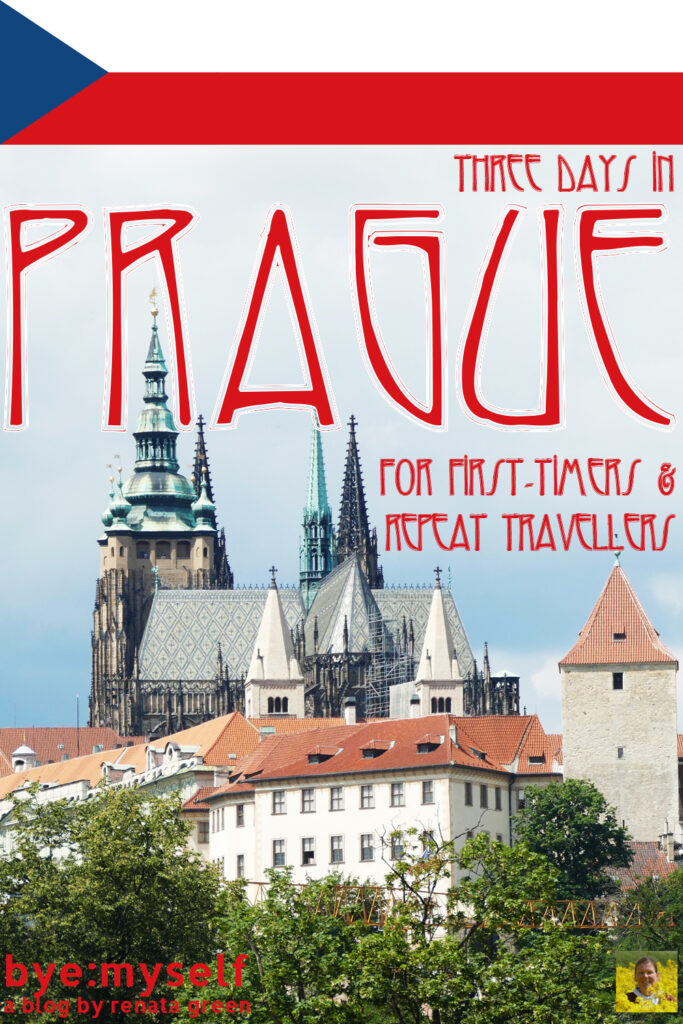

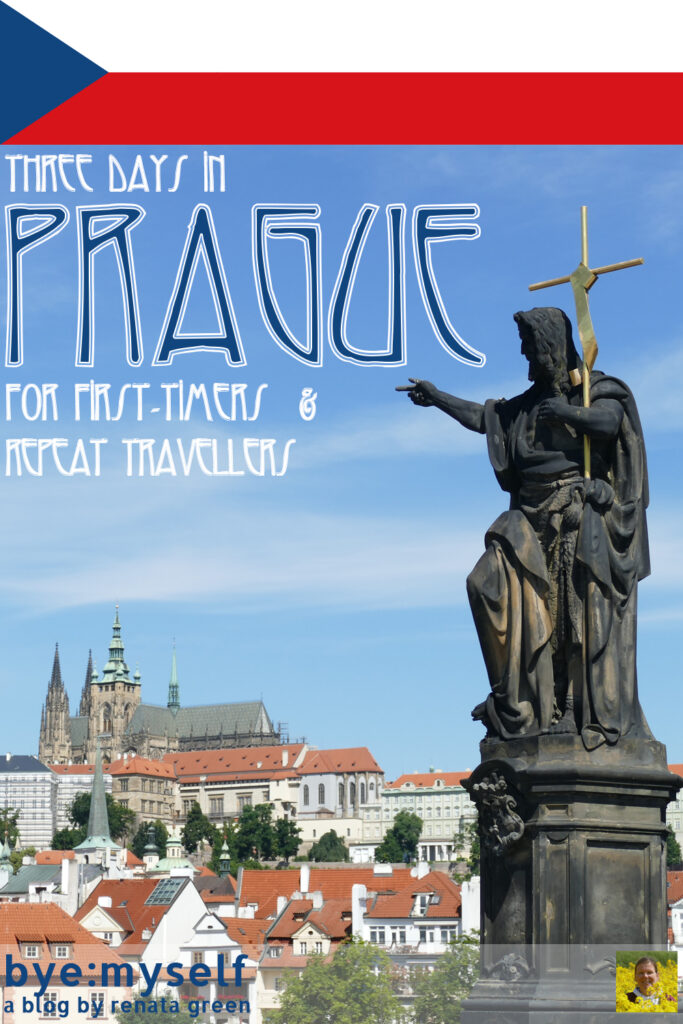
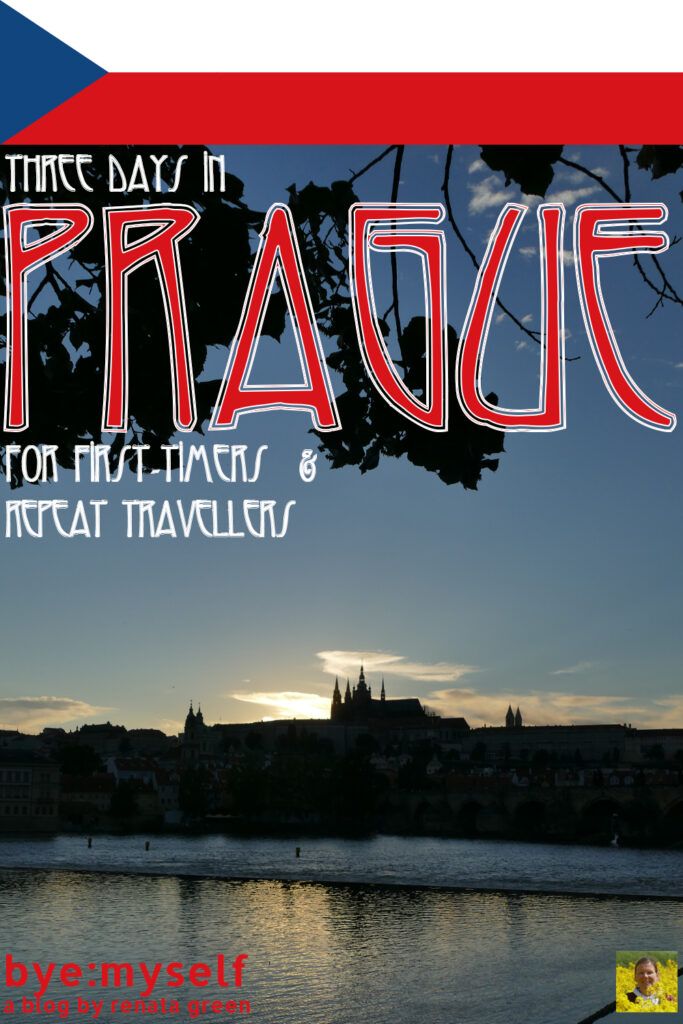
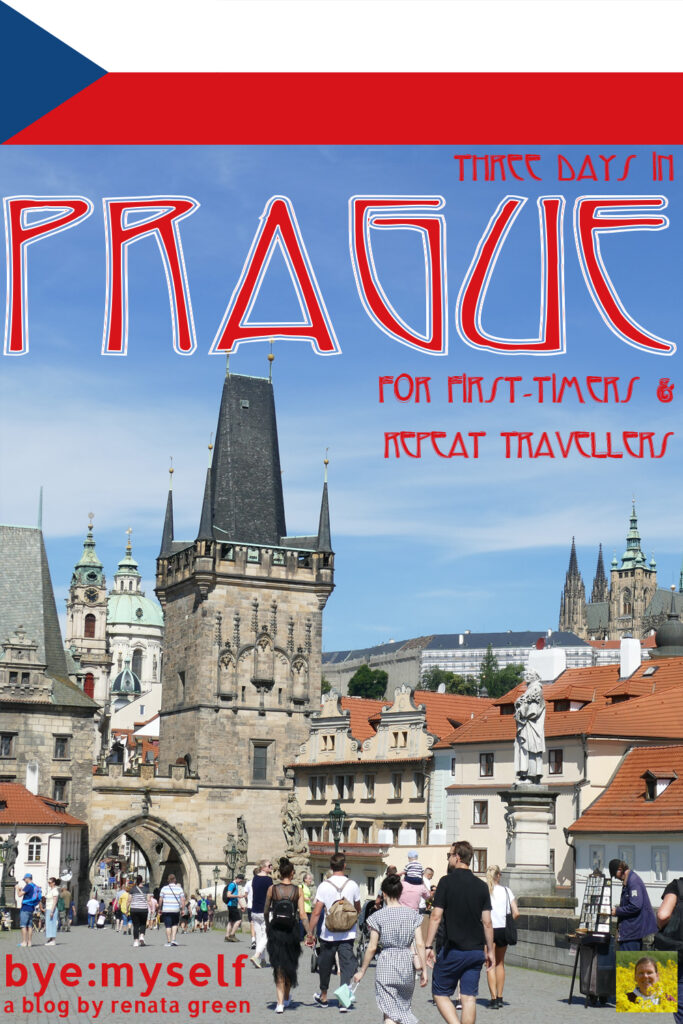
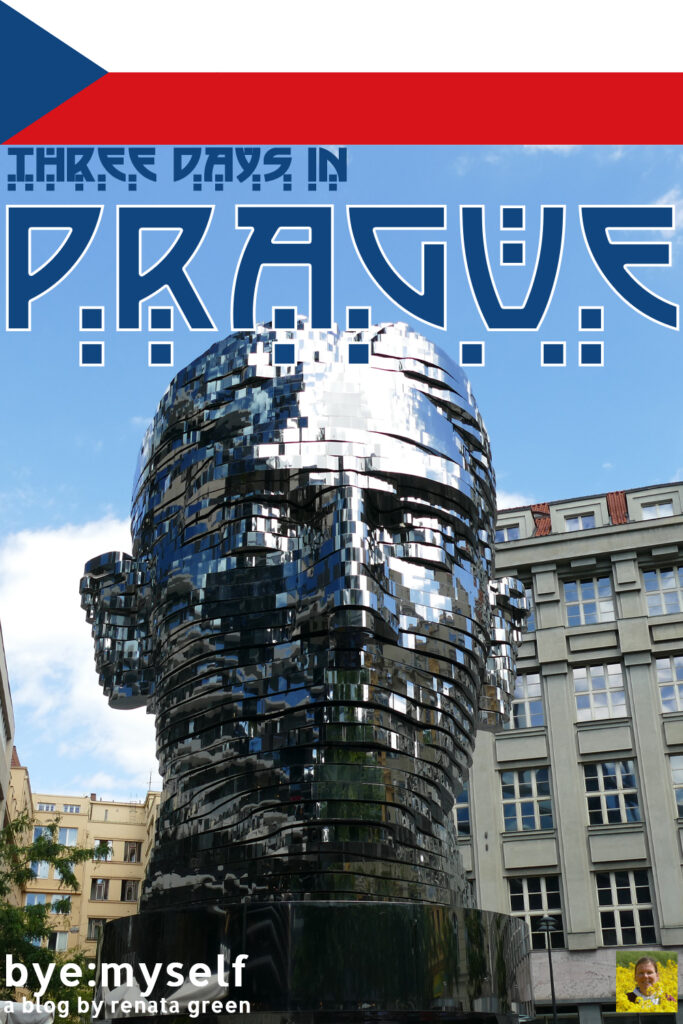
Did You Enjoy This Post? Then You Might Like Also These:
LJUBLJANA Mon Amour: What Not to Miss During Two Days in Slovenia’s Beloved Capital
Best Things to Do on a Long Weekend in Milan
VENICE on a Budget: When to Go, Where to Stay, What to Eat, And Much More
Two Days in MARSEILLE – What Not to Miss in the Belly of France
VIENNA – visited by streetcar
One Day in SANTA CRUZ de TENERIFE
Best Things to Do in SEOUL: The Must-Dos And the Hidden Gems
Four Days in AMSTERDAM – Unique Things To See on a Long Weekend
Disclaimer: Thankfully, I was The Emblem Hotel’s guest. However, all opinions on their services are mine and were by no means influenced by my cooperation partner.
* This is an affiliate link. If you book through this page, not only do you get the best deal. I also get a small commission that helps me run this blog. Thank you so much for supporting me!

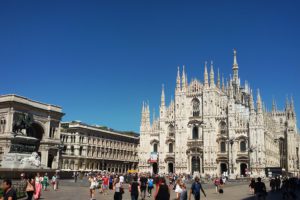
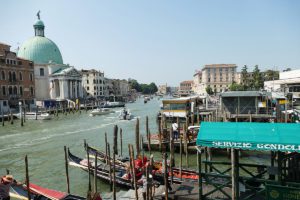
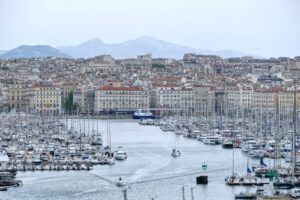
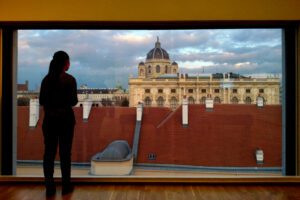
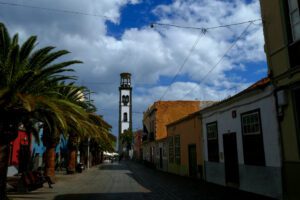
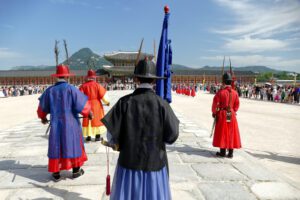
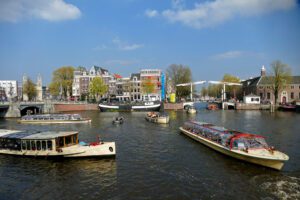
Cool. I spent a long time looking for a comprehensive guide and found that your article gave me all the information needed. Thank you!
You’re welcome – I hope you have a safe trip!
Honestly, we find it pretty funny how tourists take pictures in Prague while eating trdelnik, but what we find even more hilarious is what prices they are able to pay for a simple dough topped with sugar and sometimes with nuts (the new hit is trdelnik filled with cream or ice cream).
I’m rather into hearty food, anyway. But yes, the trdelnik 2.0 with cream and ice cream looks pretty impressive 😀
Wow I just love the architecture in Prague and love around Sacral Structures and the powder tower.
I did not know you were from Czech! My partner is Czech so I have spent a lot of time there. He is from near Brno though, so there is definitely some rivalry in the air, so I can’t tell him that I (of course) loveee and prefer Prague over Brno. It’s just such a romantic and beautiful city, which you captured perfectly here. And the FOOD!!! Those pictures bring back memories, just missing some bramboraky and it’s too perfect.
Bramboraky – yes, one of the heavy carbohydrate dishes 😀 And yes, Czechia is – like for instance France – one of those countries where the capital makes it impossible for any other city to ‘shine’ 😉
Fantastic post! Such a comprehensive guide to a short trip, the Wallenstein Garden is awe-inspiring – truly fit for royalty!
I’ve discovered it only on my latest trip to Prague and found it absolutely magic 🙂
This post took me back to lovely memories of Prague – the incredible architecture, chilling along river Vltava, the scary ghost tour that we took, and a lot more! Would love to visit Prague again, with kids!
What a great view through your eyes back to Prague. We had a week in Prague and felt we could have used more time to just sit and soak up the city vibes. And we did not even get out of the city. We too were surprised at how beautiful Prague was. Every corner brought a new discovery. We dropped exhausted in bed every night from wandering all day. You got some great shots of the stained glass at St Vitus.
I’m so annoyed that I missed out on so many sights whilst I was in Prague years ago! Agree that Charles Bridge is beautiful but that’s probably a given.
I have a different story. My great-grandparents came from Czechoslovakia to the US in the 1920s, but because their children and grandchildren were Americans, they weren’t allowed to visit until the 1990s. My grandpa has reconnected with family in the Czech Republic, but I want to go someday to meet them.
Yes, of course, during the cold war, all American was banned. I think it will be very exciting for you to meet that part of your family 🙂
I agree with you, locals sometimes skip on places thinking it’s not worth a visit or something like that. Great guide, thank you for sharing!
It is such a comprehensive and detailed travel guide and thanks for sharing with us,
I love Prague for being one of the most romantic cities in Europe, and I hope to visit there again, this time in Spring! – Knycx Journeying
I think Prague is perfect for the weekend trip. I spent there a weekend once and a whole week the other times and while spending a week I used Prague as a base for travels across the country. Your guide seems perfect to me
After reading your post, I feel like Prague should be the first place to go when resuming my travel habit. The pictures are amazing.
This article was great! I learned so much. I had no idea the history of Wenceslas Square. After reading this article I want to visit.
never been in his place yet but looks nice and have historic places….been in spain Portugal,France,Greece,u.k,norway,Finland,Germany…my favorite is spain
Prague is a beautiful city and may someday I visit there. Thanks for sharing your experiences and detailed guide to the city.
I’ve been dreaming of visiting places like this. I want to travel to Europe and Prague is number one on my list! Thanks for making my life easier by writing about the itinerary of this place. I hope one day to visit there soon.
I’ve never been to Prague but always wanted to visit so this is a great resource for planning a trip there. Thank you for sharing!
I love Prague and have been a number of times, I do love your guide.
I love hearing about your childhood and traveling experiences! Great read!
This is such an extensive list of things to do in Prague that can definitely help anyone planning a trip to this iconic European city. I could easily spend a week in Prague marveling at the stunning architecture, the views from various vantage points, and indulging in some of the traditional bohemian cuisine.
I believe this is an informative post and it’s extremely useful and knowledgeable.
I really enjoyed reading this postBigig enthusiast, thank you!
King regards,
Mead Duke
Such an extensive post on Prague. My boss comes here every summer and now I can see why. It really is a beautiful city.
I love Prague and been there number of times. In fact there was a very popular Bollywood movie called Rockstar that was shot there in 2011 and it strongly put the city on my travel map. I love the city for its squares, towers, monasteries, abbeys, underground medieval pubs and even the new part of the city across the river.
Wow! This is such a comprehensive and insightful itinerary for Prague. In all honesty, it sounds like I could easily spend 30 days here instead of 3, exploring the city in all its magnificence! I especially appreciate the thorough historical context you provided; much of which was, sadly, off my radar growing up. How poignant that these events touched your life as a child. I can only imagine your feelings when you discovered “home” was not what you expected it would be. Thank you for sharing your perspective and vulnerability, and this incredibly beautiful, historic city. <3
As many others have said, thank you for sharing your personal story. And, what a fantastic guide to Prague. I love walking over bridges, and I am very interested in Jewish history. I always visit the Jewish museums, quarters or especially historic synagogues anywhere I travel. I appreciate the thorough and helpful guide, and especially the thought and emotion you put into writing it. One day I hope I can visit the places you’ve described.
I have been told that Prague is one of the most beautiful cities there is, but I had no idea that there was so much history! I especially found it fascinating reading about the physician assisted suicide of Freud. I learned about him in school, but I didn’t know this about him. I loved reading your own story as well and can understand why you would feel German, as Germany is where you have spent the majority of your life since a young child.
Prague looks so beautiful with an old world charm. So much to see and experience. Looking at the beauty, one can scarce believe the poignant history the place has. It was really touching to read about your own personal experience. I empathize your feelings when you identify more with Germany.
Wow what a detailed description of all the sights to visit in Prague, the region’s history and your connection!! Prague is one of my favorite cities with the beautiful architecture, squares. bridges, towers, churches and so much more.
Wow so much history and so many recommendations/experiences in one post. This is incredible. I am definitely bookmarking this for when I finally get to go to Prague.
Also, I could never imagine being a child in a place I couldn’t speak or understand the language, that must have been so scary, but also what an awesome story you have to tell now.
I think you have put it beautifully that while locals know certain hidden gems, they might be desensitized to some iconic locations having seen them so many times that they are bored of it now. I feel that about Burj Khalifa (I live in Dubai) too. Prague, just like you say, is one of the most beautiful European cities in my opinion too and I’ve travelled quite a bit in Europe. I absolutely love the architecture and the vibe of the city. Your list of things to see is really detailed, I’m just not sure if its possible to cover all of this in just 3 days! I was there for about 3 days myself and managed to see quite a few of the things you’ve mentioned but also missed out on several! But its comprehensive enough for someone to pick and choose as per their interest!
Thank you for your detailed comment. Yes, you are absolutely right, my list is very long and I must admit that I spent far too little time at some of these places. Knowing that I had only three days, I practically raced through. One could definitely spend about a week without getting bored. Happy travels!
This is a really extensive list of things to do in Prague! I travelled there around 8 years ago and stayed for 2 nights, but definitely missed out a lot of these spots as we only had limited time to walk around. I’ll be saving this for my return trip to the city!
Prague was not somewhere that was necessarily on my radar to go visit, but this definitely makes it sound like a place to go. Great article
Prague was a city I wasn’t expecting to love, but fell head over heels for! I was there for new years eve so it was a bit cold and VERY crazy! I would love to go back during the warmer months!
I’ve never been to Prague but my brother lived there for a few years and absolutely loved the city. It has some of the best architectures and I’d love to see with my own eyes some day!
There are so much to see and visit around Prague and I doubt if I can explore these in just 3 days. Their gorgeous towers, bridges, and squares alone will just enough to visit for a short period. It is amazing how Prague is one of the city rich in culture and history, definitely a must-visit. Do they still have the famous Prague music festival?
This is such a comprehensive guide to Prague that it really shows why one must not miss visiting this fabled city!
This is such a well researched list of things to do and see in Prague. I have always wanted to visit and hope to make it out there sometime in the next few years. I agree that there is so much history and narrative to Prague and experiencing that is a must.
What a thorough and extremely insightful post , will save for my visit to Prague . Love the in depth descriptions and history of the statues , churches , etc . It was nice to integrate your personal story throughout the post.
I have been to Prague and spent 4 to 5 days here and was totally awestruck with its lovely historical vibes. I loved Old town square and Wencelas square and here walking is really great to explore this city. Charles bridge is my another favorite spot here.
Wow, this post is so informative! Thank you so much for sharing! I loved hearing your personal history weaved throughout the guide 🙂
Before reading this post, I hadn’t ever really thought to prioritize a trip to Prague but now I absolutely MUST get there! Thank you for writing so deeply about the Churches and Monasterries! I loved seeing the stained glass and the stories in them! I will have to get to Prague soon and see it all for myself. And the food looks amazing!
Oh yes, for you, Prague will be a Dorado: They have something like 180 churches and then there are abbeys and what not. You’ll never leave 😀
I love Prague’s architecture! I didn’t think you could see so much in 3 days, that’s good to know. Thanks for sharing.
Wow, this post is so informative! Thank you so much for sharing! I loved hearing your personal history weaved throughout the guide!
What a comprehensive overview of Prague, I love yout attention to detail.
I haven’t visited Prague yet, but it has now been added to my post-lockdown list.
Wow! this is a great post! I didn’t know about the native language and I was so interested to hear the story of your life! The bridges look beautiful and Old town Square seems like a great place to start a tour of the country !
I loved your personal story. My father in law has a similar experience. His family owned and operated a textile business. During the war their operations were occupied by German soldiers to support the war effort. My father in law has fond memories of that occupation, the soldiers were nice to him and treated the family well. That all changed when Russia gained control of Czechoslovakia. They removed them from their family home (they were to live in the servant quarters), abused them, stole their money, etc. The family decided to escape- gave up their land, business and baron titles. When liberation took place in ‘90s my father tried to regain the land and business. Unsuccessfully. I returned with my husband’s family and learned his story and saw the once beautiful home and properly abandoned and destroyed by Soviets.
Yes, we should be grateful that we’ve lived in peace for decades now.
What a fab post and love reading about your Czech connection. I’ve wanted to visit Prague for a long time but have been a bit put off hearing about the crowds in the past. But now is probably a good time to go. I never realised there was so much to see, nor was I aware its a fave stag and hen destination. The hotel sounds a great stop to stay, I shall check that one out. I like central but not noisy hotels!
That’s why I rushed there now: To avoid the crowds. And yes, it worked out. Indeed, the hotel is very nice and in a perfect location.
I can’t imagine being dumped into daycare and not knowing a word of the local language, it must have been so alien. But I bet it’s equipped you for dealing with all sorts of uncomfortable situations. I’m yet to visit Prague, but you’ve painted an enticing picture.
Yes, it was pretty tough. On the other hand, growing up bi-lingual certainly armed me for many more languages to come 😉
Your post brought back such great memories of Prague. We were there for a week and there was still so much we missed. As an architecture geek, I spent many days with my head looking up at the beautiful buildings. We did not get into the museums and missed Schwarzenberský palace. Good options for rainy days. We walked a lot. But also found the trams to be a great way to explore. Definitely worth a return visit.
I was such a busy visitor – and there is still so much I’d like to see or visit with more time. So – as you say: worth a return visit! 🙂
Very informative. Would love to use this post our next trip
A very thorough read and interesting to hear more about the history of Prague rather than just a list of what to do. I have been there once but would like to return (should have done so in April!) and I will enjoy re-discovering areas that I may have missed before,
Well, I think we all have a place where we should have been this year….hence, I feel very privileged that I was able to spend a couple of days in Prague.
What great details and information. Cant’ wait to travel again.
Before pandemic, Europe was one of the places where I wanted to visit. Prague was in top of my list. But now I can just read blogs and cherish these photos.
Things will change – stay positive 🙂
Loved Prague when I was there in 2009 – must return!
Great post with lovely photos.
Prague is an amzing city to visit. I been there on my senior high school trip and had a blast. Such a vibrant place.
I can imagine… 😉
Thank you so much for writing about Prague! It’s my hometown and I miss it so much after 20 years of living there. I loved all the photos and research you put into this. I even learned some things about my own country that I hadn’t known! Great article, please keep up the great writing!
Sometimes we are simply too close to where we live and need someone else to point things out 😉 Happens to me all the time 😀
Oooo this is definitely a place I want to visit one day! Thank you for sharing your journey!
Prague is one of my dream places to visit because I love their tourist spots your photos make me jealous HAHHAA.
Glad to bump into your site, Prague is the next destination that we are planning to go when all of this pandemic thing went well. Atleast less time for me to research now , saved this for future reference
So glad the post is useful for your upcoming trip!
I would love to just walk around and see all the history prague has to offer. I love architect and would flip bricks if I saw the Great South Tower of the Saint Vitus Cathedral in person.
So much beauty and culture. I can’t wait to one day visit!
This is an amazing post. Prague is such a beautiful place to explore. I’ll keep this place in my list for my next world tour.
Looks like a beautiful city! We missed going to Prague in our last trip to Europe. Will definitely plan sometime soon.
That is such a beautiful post with detailed information and you personal experience. This would be perfect guide to visit Prague. I never knew Prague was so beautiful, now I have added it to my Europe bucketlist.
OMG, there are so much to go here in Prague. Prague will be my next in line to the most beautiful places in Europe, next to Venice ofcourse.
I love reading your personal stories and experience. The article captured every little detail that awoken my curiosity about Prague.
I love, so much, your personal history interspersed in this travel post. It adds a completely unique layer to Prague. I appreciate all of the great details here and can’t wait to visit the city. It’s come highly recommended by many people.
Thank you, so glad that you’ve liked the very personal twist 🙂 Prague is truly beautiful – I’m sure you’ll fall in love with the city, too 🙂
What a great, thorough post! I adore Prague. And I agree, Venice and Prague are the most beautiful cities I’ve ever seen. I was blown away by Prague. Growing up I never heard anyone talk about going there or wanting too; so after I went I felt like it was a completely underrated city. It’s lovely, feels like home to me a bit! I didn’t get to those lovely villas, so that will have to be my trip for next time!
Thank you so much, glad you appreciate it. And yes, next time you visit you should go to Bubenec – those villas are just exquisite 🙂
When I go to Prague – which is high on my list I’ll be a first time visitor. I appreciate all the details you’ve outlined here and will be referencing for the future.
I also want to mention I was touched by the story of your mother’s return and how you describe your own experience.
So much to talk about on that topic. Thank you!
Thank you! I hope you’ll enjoy Prague as much as I did once you visit 🙂
Despite Kafka being an absolute legend, especially in Prague, I didn’t get to take ANY tours about his work or life. I was really bummed. I REALLY dove into the pieces you’ve written about his statues and works around the city. They truly are something you can marvel at for a while, I have some interpretations for one of them, the top one, but I don’t know that they are accurate!? Lol
Actually, isn’t that one of the beauties of art – that everyone can interpret whatever she likes?! So go for it – there is no accurate, I think 😀